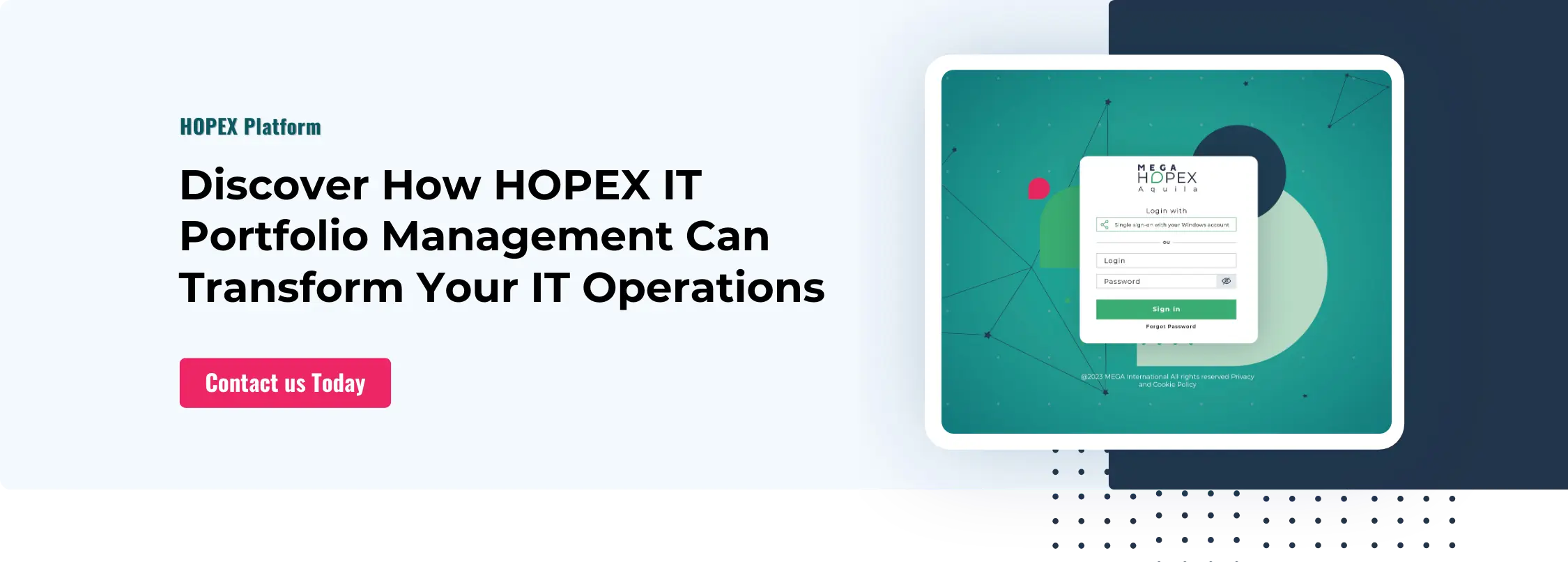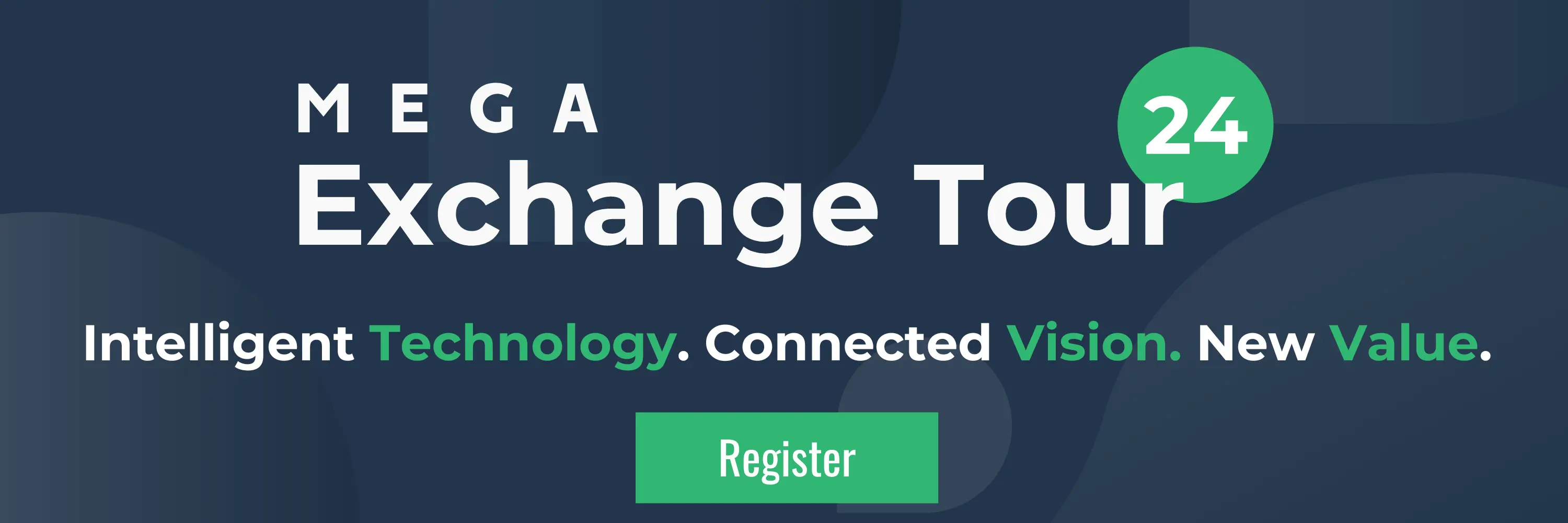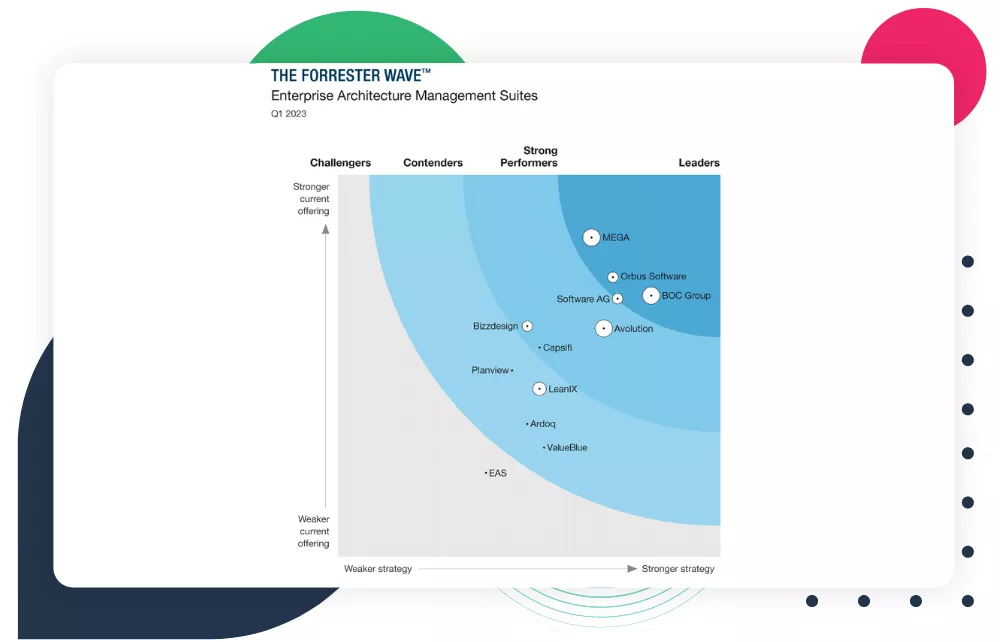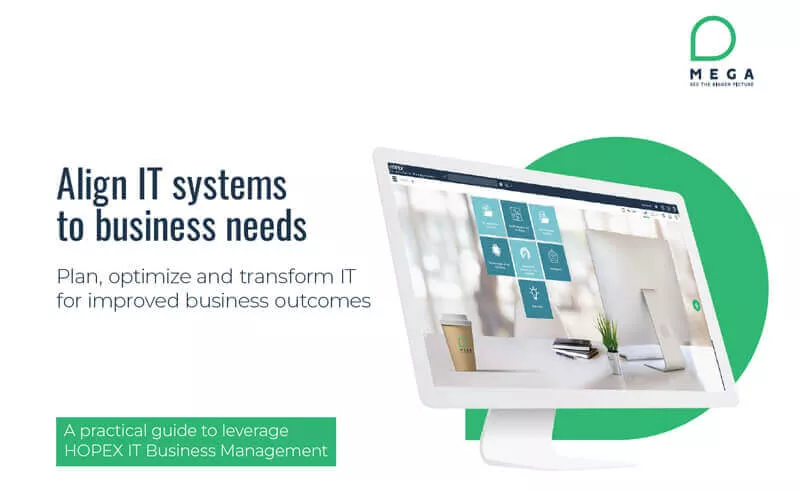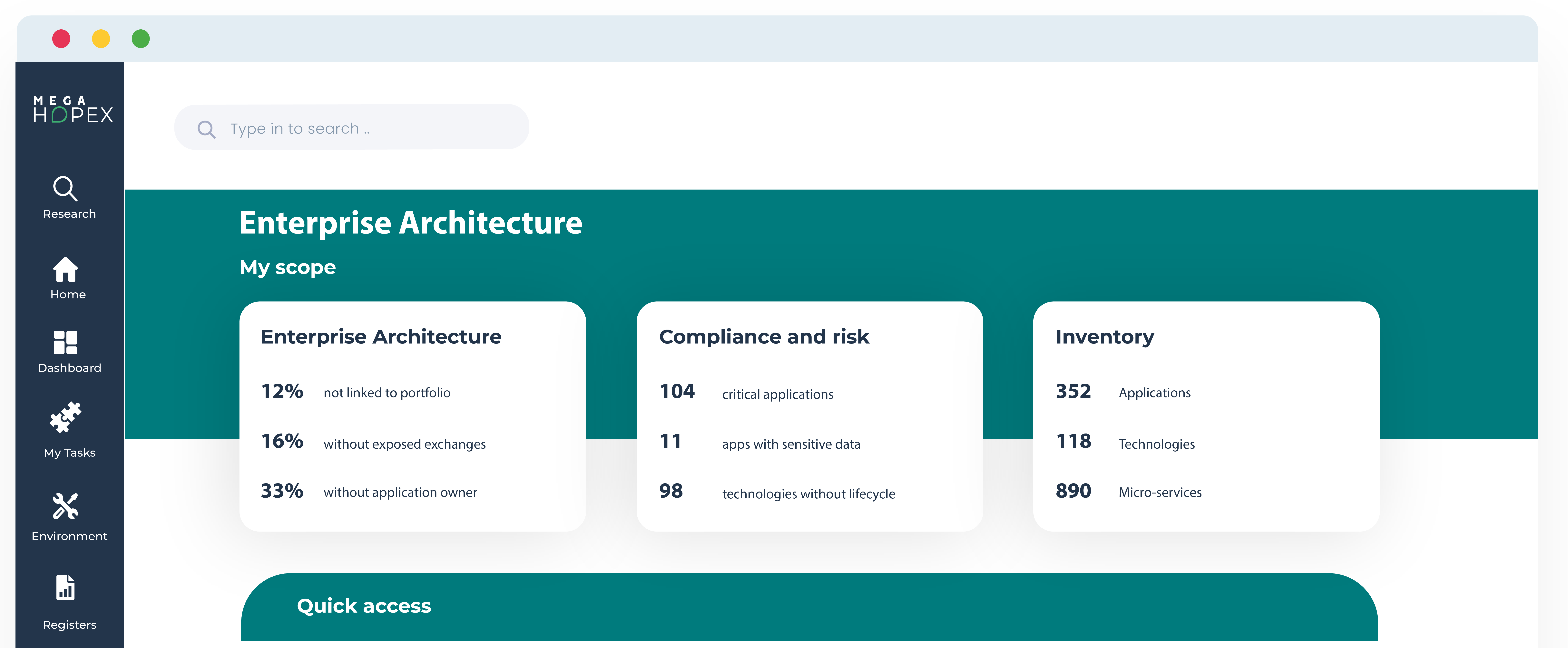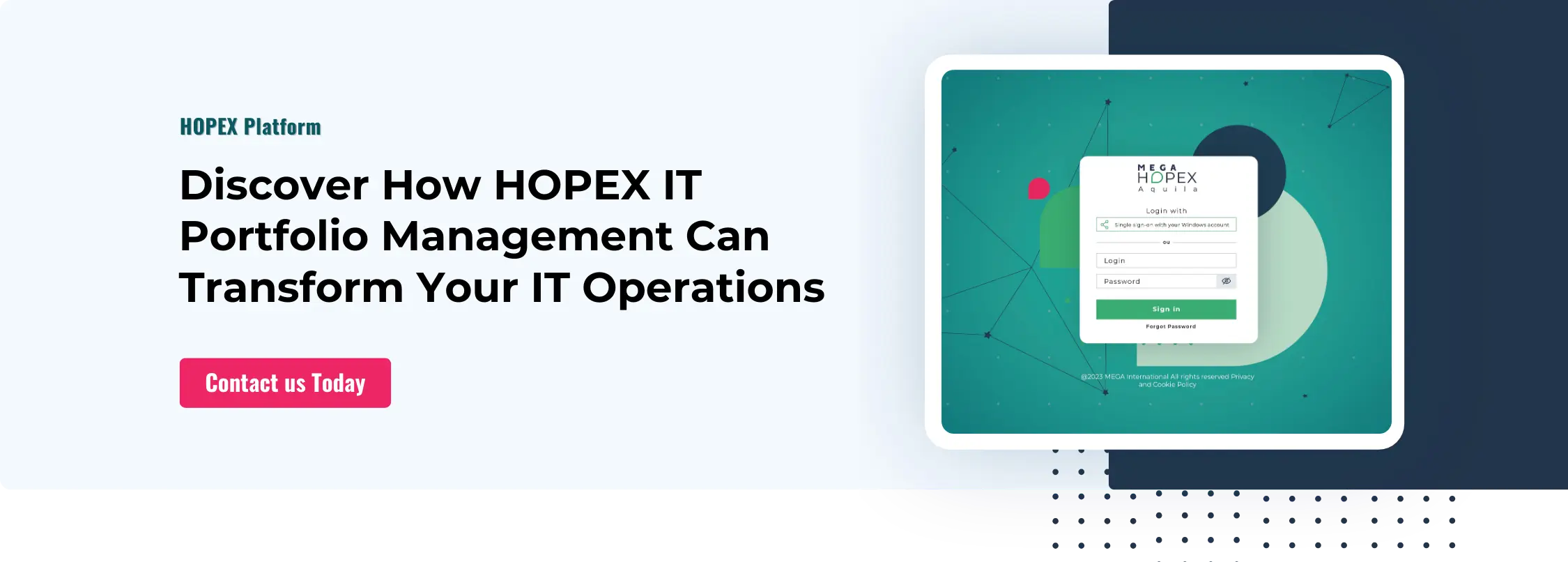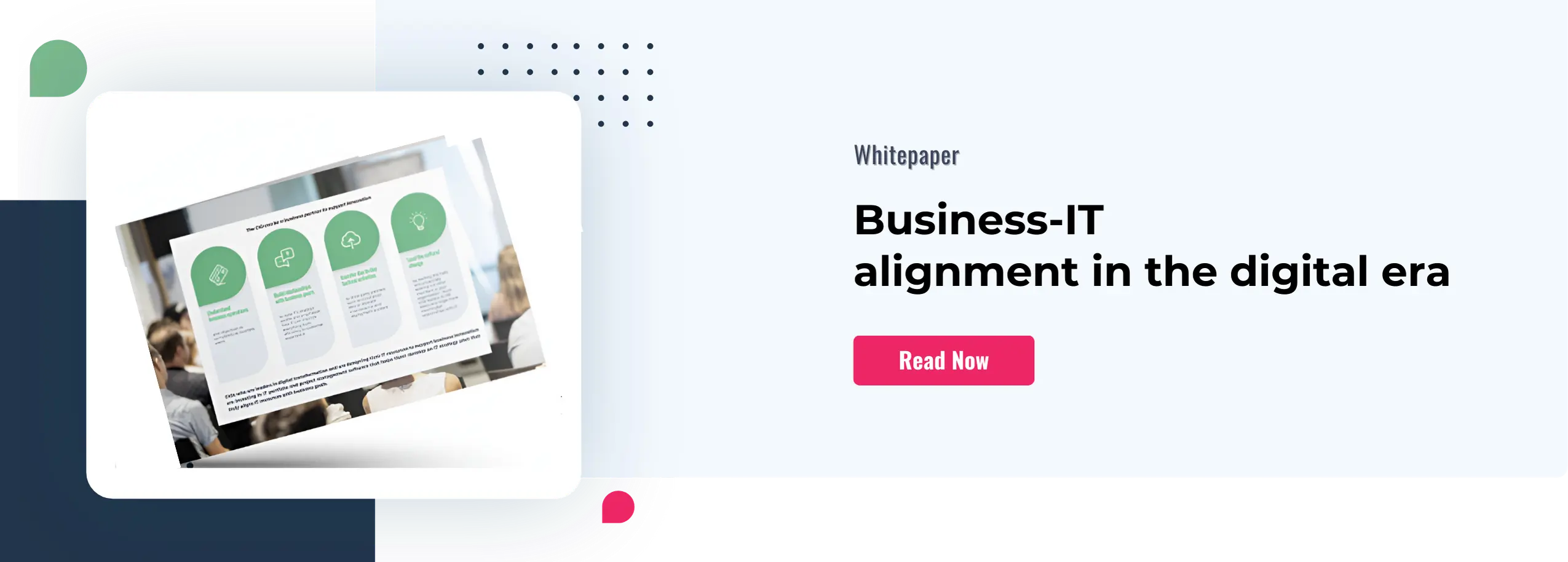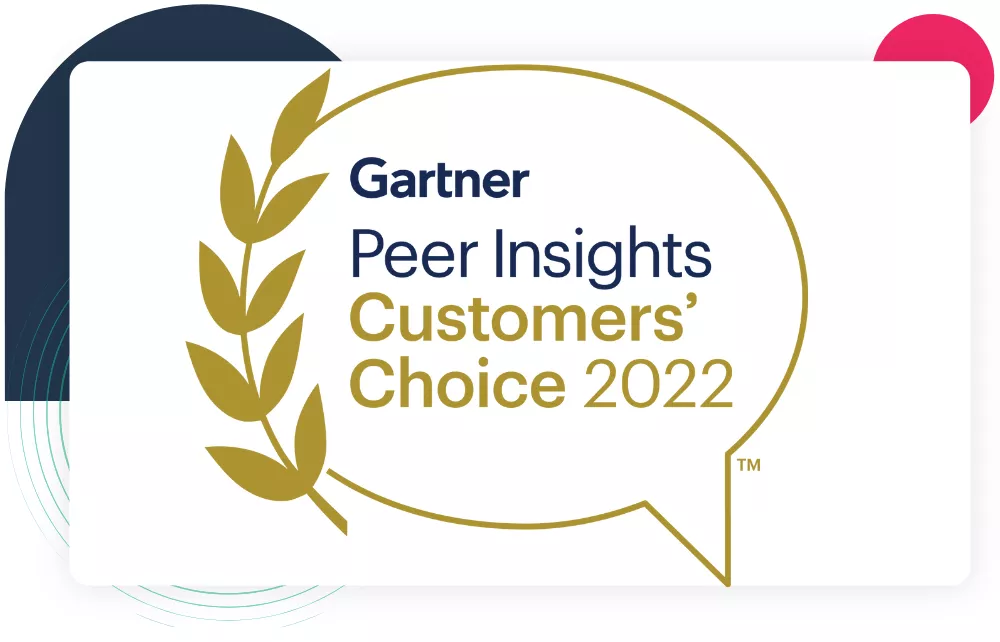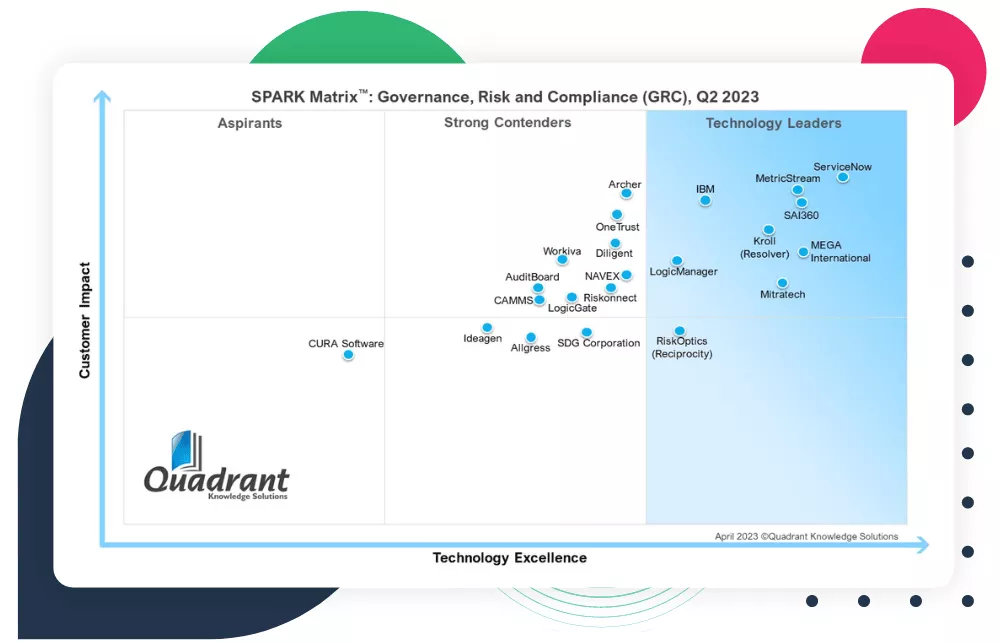Application Portfolio Management Introduction and Best Practices

Application Portfolio Management Introduction and Best Practices
https://www.mega.com/blog/everything-you-need-to-know-about-business-capabilitiesTechnology has revolutionized how companies manage their applications, and Application Portfolio Management (APM) is at the forefront of this shift. APM provides a comprehensive approach to managing all organizational applications, from the initial design and development stages to ongoing maintenance and optimization.
IT departments manage thousands of applications but must know which ones are strategic and bring less value. The number of these applications has grown significantly over the last decade, incurring increasing IT costs and risks.
With APM, IT managers can efficiently rationalize their application portfolio while ensuring their IT systems are ready to accommodate new business projects.
In this post, learn more about Application Portfolio Management, how to implement an APM project, and the best practices.
What is Application Portfolio Management?
Application Portfolio Management (APM) is a process that helps organizations to identify and manage their applications. It involves understanding the various components of the application portfolio, including hardware, software, infrastructure, and services. Furthermore, APM can help identify opportunities for cost savings by eliminating redundant or unnecessary applications.
Lastly, APM enables organizations to monitor their applications' effectiveness and ensure they meet their users' needs. By leveraging APM, companies can allocate resources better and improve the efficiency of their IT environment.
Making Sense of App Portfolio Management Strategies
APM tool manages the entire lifecycle of an organization's applications, from development to deployment and maintenance. It provides visibility into the performance of existing applications and the ability to develop new ones more quickly and efficiently. APM enables organizations to understand their application landscape better, prioritize investments, and identify areas for improvement.
It helps identify which applications are most critical for business success and provides insights into how those applications can be optimized for better results. By identifying redundant or outdated apps, APM can help organizations save time and resources by streamlining operations and removing non-value-adding applications from their portfolios.
APM ultimately provides organizations with a comprehensive overview of their application landscape that can be used to optimize performance and drive value.
Why is application portfolio management important?
Application Portfolio Management is an invaluable tool for any organization dealing with the complexity associated with multiple applications.
By mastering the complexity of multiple applications through APM, organizations can ensure their systems are always running efficiently and effectively. APM helps identify and report on performance issues within an application so that IT staff can quickly diagnose problems and take action to remedy them. Furthermore, APM can help identify potential bottlenecks before they become major problems, allowing for proactive solutions that save time, money, and resources.
IT Departments' challenges: Main examples of APM
Increasing complexity and a lack of flexibility
IT departments are often burdened with applications from past mergers and acquisitions, geographic expansion, or organic growth. These applications have been accumulated without a planned roadmap; many are redundant, under-used, or obsolete. This results in complexity and a loss of agility, preventing IT departments from supporting new business projects.
Growing IT costs and IT risks
In addition to soaring IT maintenance costs, these applications can induce obsolescence or non-compliance risks. In many cases, IT teams can only downsize these applications with precise business value knowledge. They cannot assess the impact of change when adding or removing an application. They may also need help migrating applications from on-premise to the cloud.
No central repository to store information on applications
Using Excel spreadsheets or home-grown portfolio management solutions is valuable and flexible when initializing an application rationalization project or for a one-time exercise. However, they rapidly become limited for repeated, long-term use, challenging rationalization efforts.
“CIOs understand that cost optimization initiative is important for the efficient delivery of IT services, but often struggle to maintain momentum and end up in a repeated cost-cutting cycle.” (Gartner, Three-Year Roadmap for Cost Optimization, 2019)
To go further, read the Main Benefits of APM.
Why do organizations need an application portfolio management practice?
Get visibility into all applications used in the organization
- Create, in a single repository, a comprehensive inventory of applications
- Get a clear view of how current applications support the business
- Identify and reduce risks
- Impose a formal process around new application approvals
Assess the application portfolio to identify rationalization projects
- Understand how and where existing applications are used and by whom
- Identify redundant applications
- Understand the critical applications and the ones to be retired or modernized.
- Analyze the impact of change.
Transform applications to consolidate the application landscape
- Reduce application costs
- Improve business alignment
- Keep IT systems flexible for new business projects
- Regiment and impose better governance on the application portfolio
Methodology: Achieve Optimal Results with Application Portfolio Management Best Practices
Creating and managing an effective application portfolio is a challenging endeavor that is essential for any organization. With the correct planning, resources, and best practices in place, businesses can ensure that their application portfolios are well-managed and current with their needs. The following is an overview of best practices for effective APM to achieve these goals.
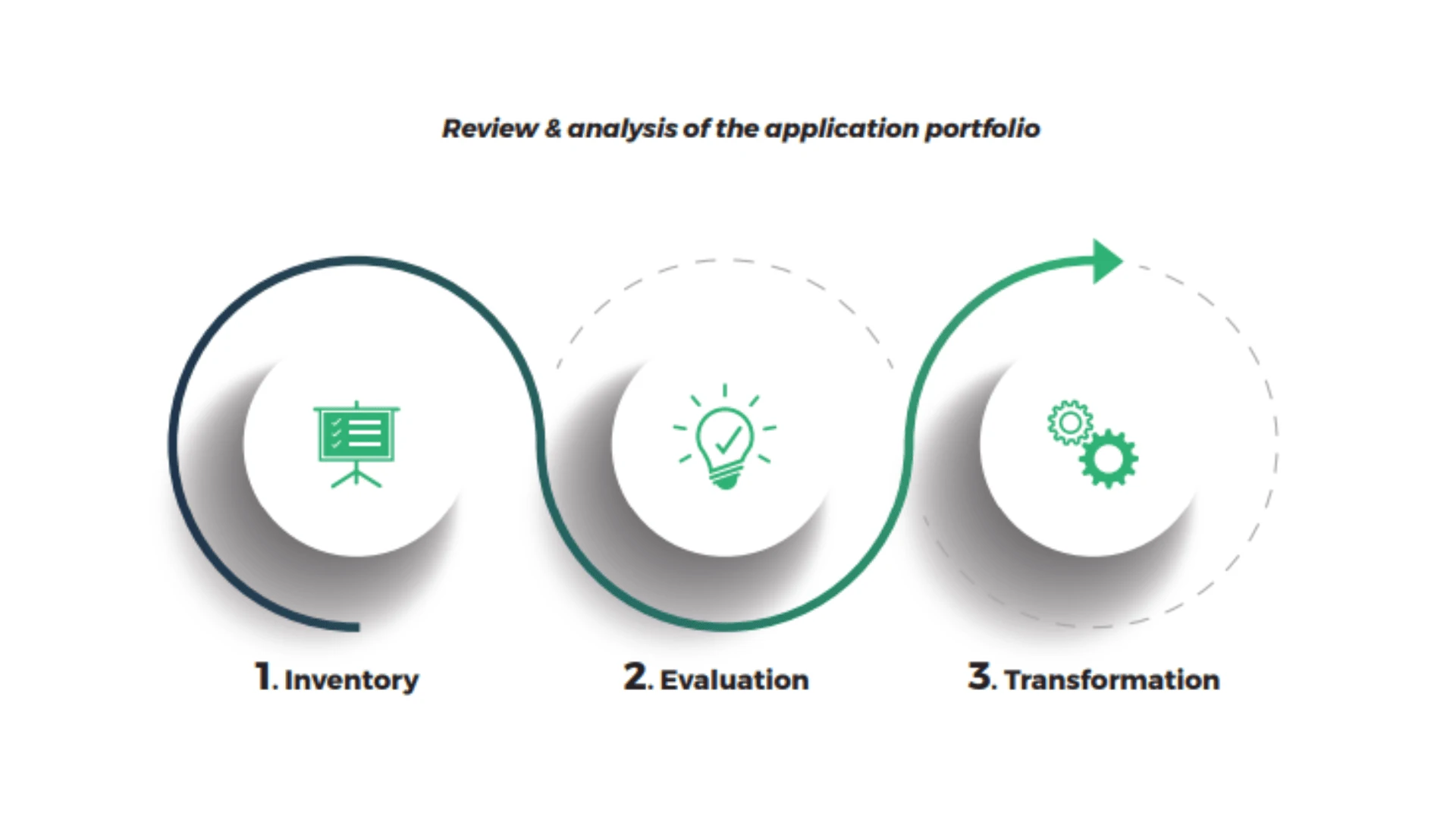
How do you get started with application portfolio management?
Learning and mastering Application Performance Management (APM) can initially seem daunting, but it doesn't have to be complicated. The key to success is breaking down the process into manageable steps. With a few simple steps, you can master APM quickly and effectively.
1st step: Perform IT Inventory
With APM, IT departments create a detailed inventory of their assets, including applications, technologies, data flows, and business capabilities, to provide a comprehensive view of their IT landscape. Based on this inventory, they can link business capabilities, applications, and technologies together to perform impact analysis. They can add other perspectives, such as application costs, deployments, lifecycles, supported processes, and risks.
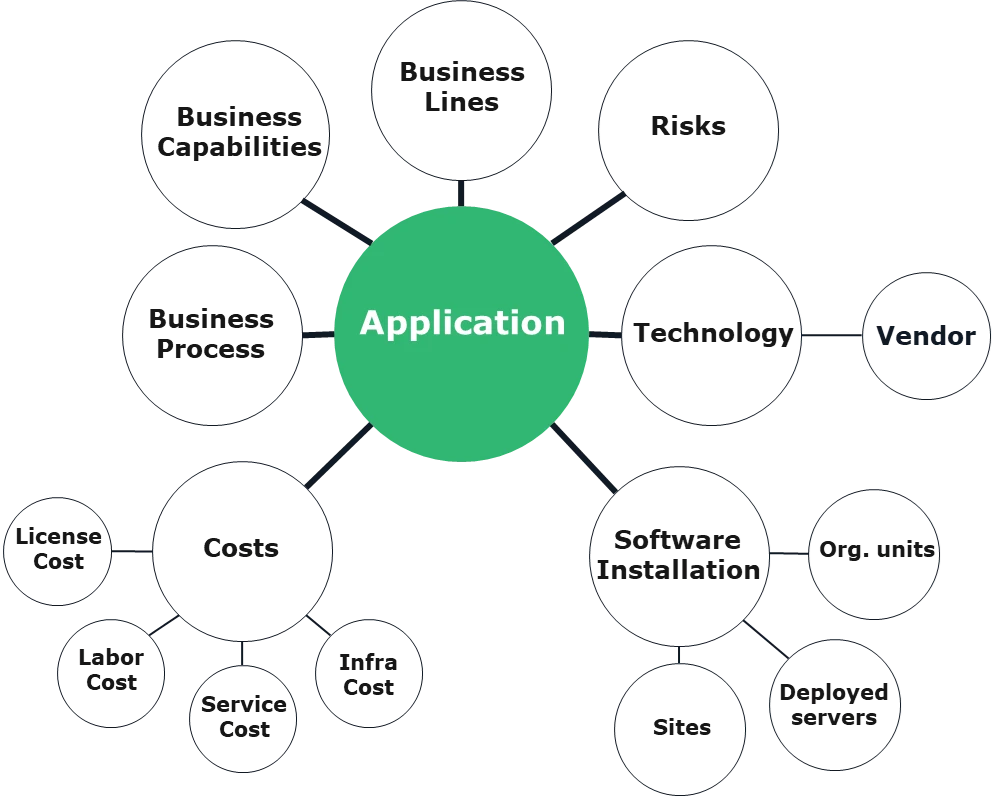
Inventory applications under multiple perspectives
A. Define roles and responsibilities
Managing the application and technology inventory is a teamwork effort. Distinct categories of stakeholders are typically involved, and their responsibilities vary from organization to organization. Typical roles include:
- Application portfolio managers monitor the application portfolio, provide reliable information about it, and work with application and business line owners to keep the data updated.
- Technology portfolio managers look after the technology assets, monitor technology obsolescence, and identify when changes are necessary.
- Application owners who manage one or more applications provide updated business and technical information about their applications for the inventory and monitor application performance.
- Business owners who provide information about the business value of the application and their satisfaction through surveys.
- IT owners provide information on an application's technical fitness through surveys. For example, they can describe the level of complexity of the architecture required by an application.
B. Plan and prepare for data collection by defining the data needed
Before collecting the application information, create corresponding reference objects linked to applications, including organizational and site structure, business capabilities, business lines, and business processes.
Define the scope of inventory, including application systems, applications, software technology, portfolio structure, and portfolio criteria. When making a list, look at these specific items:
- How applications support business activities (lines of business, business processes, business capabilities)
- How applications interact with each other through data flows
- Where applications and technologies are deployed (company branch, site, server, consumers)
- Application costs, including recurrent, non-recurrent, maintenance, and labor costs
- Application lifecycles and their corresponding deployments
C. Collect data
Speeding up and automating the collection process at that stage is essential. You can use and set up APIs to connect and retrieve data from third-party solutions available in your organization. The collection process can also be crowdsourced to application stakeholders who will provide accurate information on their applications.
- Identify existing sources of information, such as spreadsheets, CMDBs, application portfolio management tools, IT asset management tools, and any existing collection processes (for example, surveys via email or web).
- Collect business data using a collaborative approach (crowdsourcing) with key stakeholders and deposit all information into a centralized repository for use company-wide.
- Design and submit relevant questionnaires to various stakeholders, including application owners.
- Validate the data collection process and the information collected by checking the accuracy of the new information, using what is already commonly known, and having stakeholders and subject matter experts verify it.
D. Enrich Application Data Inventory
Once the initial data collection has been performed, several ways can be found to enrich the application inventory: for example, by linking business capabilities to applications and applications to underlying technologies and by defining application lifecycles, dataflows, costs, and deployments.
- Map business capabilities to get a clear picture of the current state from a business perspective. Link applications to business capabilities to view the applications that support business capabilities.
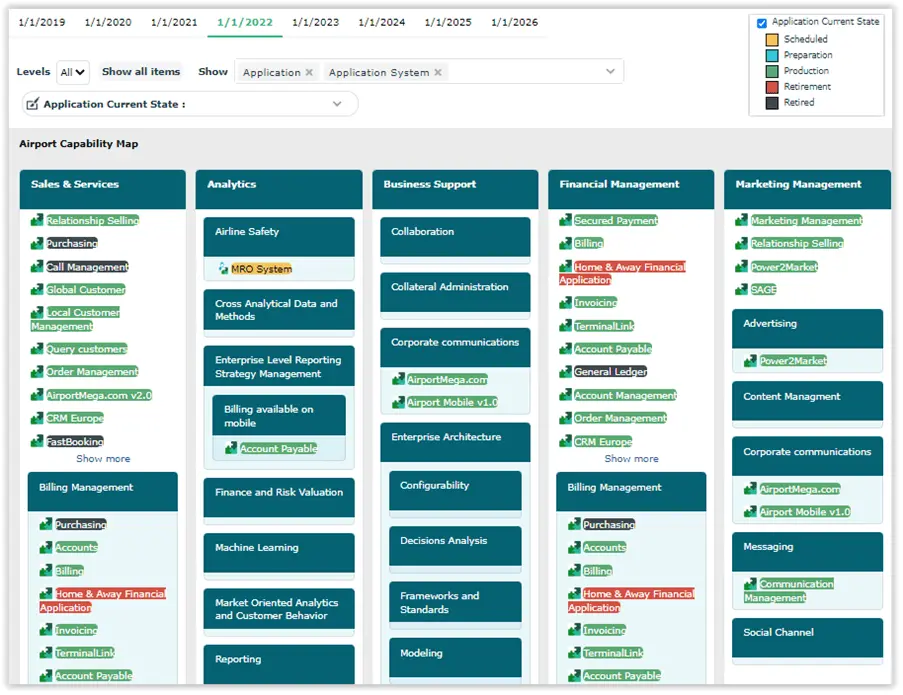
View how applications support business capabilities over time.
- Map underlying technologies to applications to get a better understanding of the technical fitness of an application.
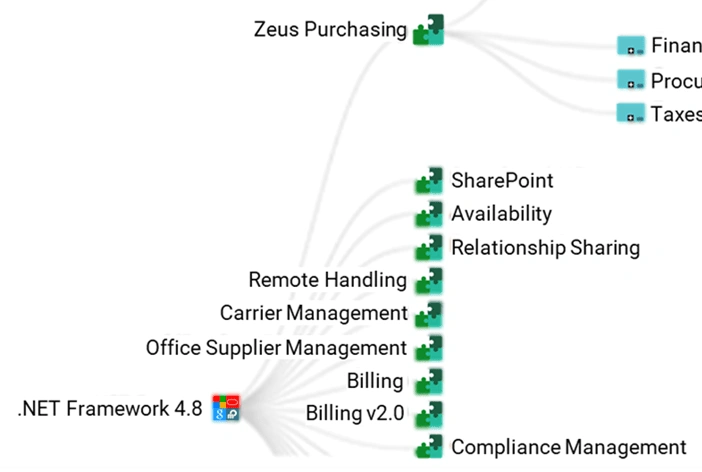
In this example, .NET Framework 4.8 technology supports the listed applications on the right.
- Map data flows between applications.
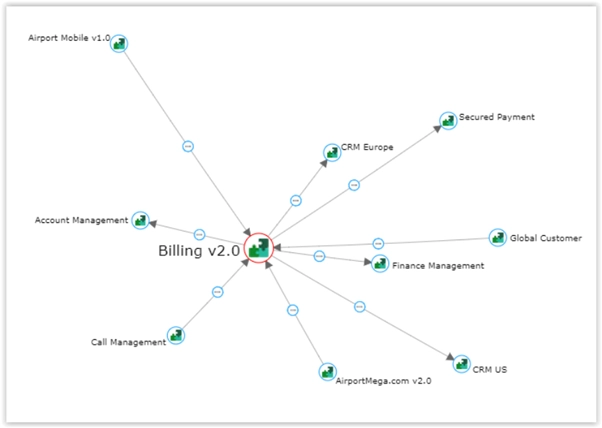
Monitor data flows between applications to understand the effort needed to remove or update an application.
- Map application deployments in the different branches and departments of your organization
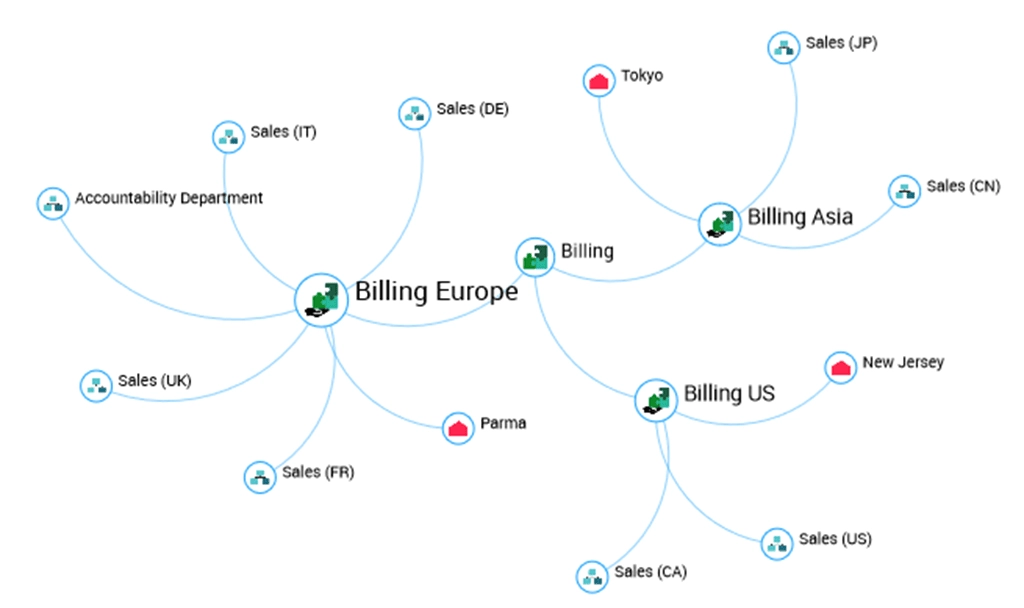 Get a clear picture of application deployments.
Get a clear picture of application deployments.
- Capture the life cycles of applications and their deployments.
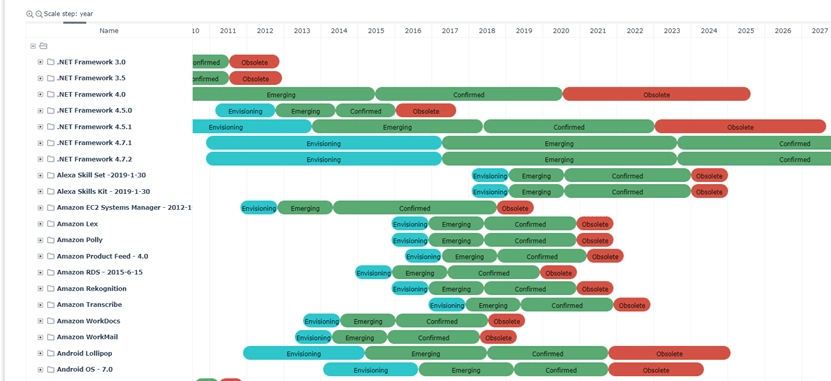
View application lifecycles as well as deployment and underlying technology lifecycles.
- Over the years, capture application costs, including labor, infrastructure, license, and service costs.
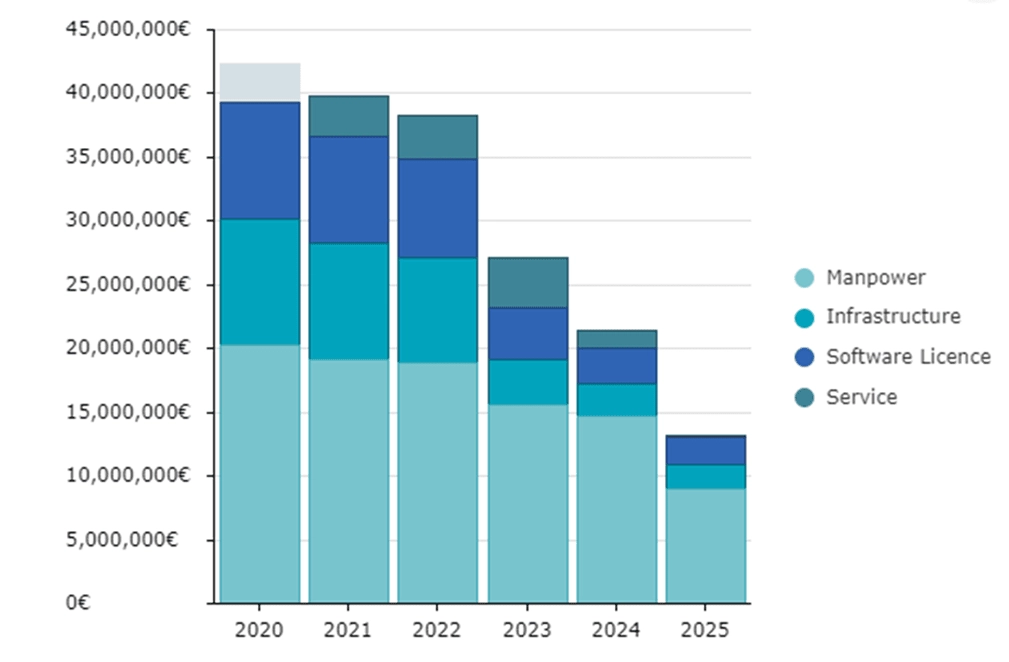 Understand application costs
Understand application costs
E. Define the approval process for new applications and technologies
Once the inventory of the IT landscape has been performed, implement a formal approval process for new applications and technologies so the application portfolio management (APM) practice is the single source of truth for applications and technologies
2nd step: Assess the application portfolio to identify the applications to be removed or modernized
Application portfolio management (APM) enables IT leaders to assess their applications and get a consolidated view of their application portfolio using various factors such as costs, application lifecycles, and deployments.
They can also send surveys to business and IT owners to measure various legacy applications' business value and technical efficiency. Through this assessment, IT leaders can make well-informed decisions to eliminate some applications that no longer fit the company's strategy or modernize applications with substantial business value but with poor technical fitness. They can even decide to outsource some applications that are too costly to maintain but still support vital business processes.
A. Run objective analysis
In that stage, you can run an objective analysis based on the collected data to assess your application portfolio. It will give you a first insight into the value of your applications.
- Using collected data, applications can be assessed based on objective KPIs such as lifecycle, cost, risk, supporting technologies, and vendor dependency.
- Align applications to business capabilities to ensure the IT roadmap supports the organizations' goals and helps meet business objectives.
- Identify redundancies as well as applications requiring attention in business capability maps.
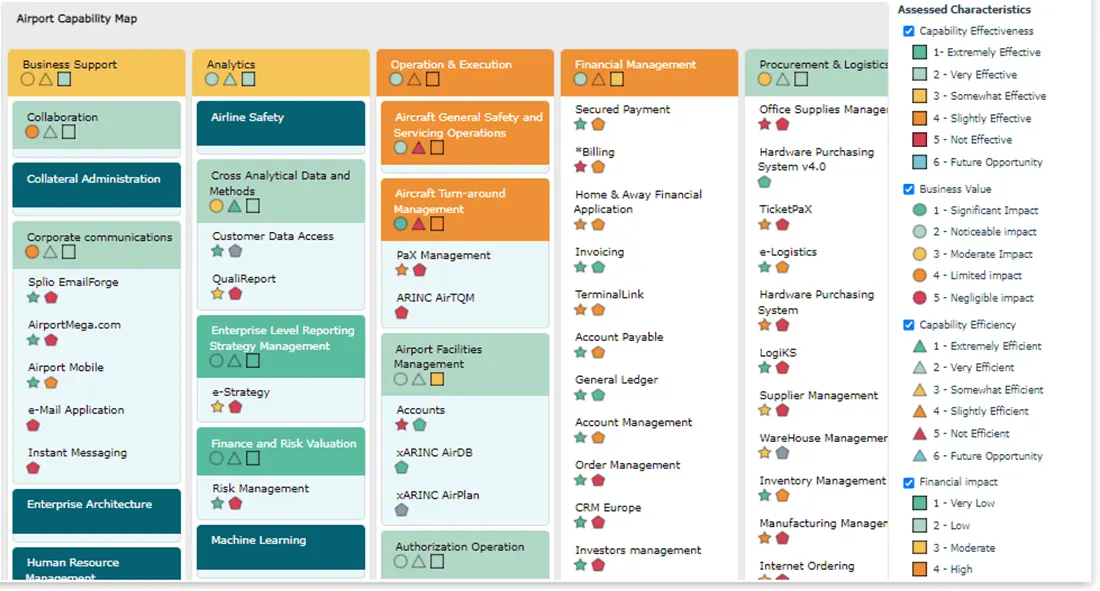
Show the results of application assessments in business capability maps.
B. Run subjective analysis
Subjective analysis is performed by stakeholders who assess their applications' business value and technical efficiency. Questionnaires are sent to business and IT owners and other stakeholders who provide the required information. Again, the assessment can be crowdsourced with the portfolio manager coordinating the efforts.
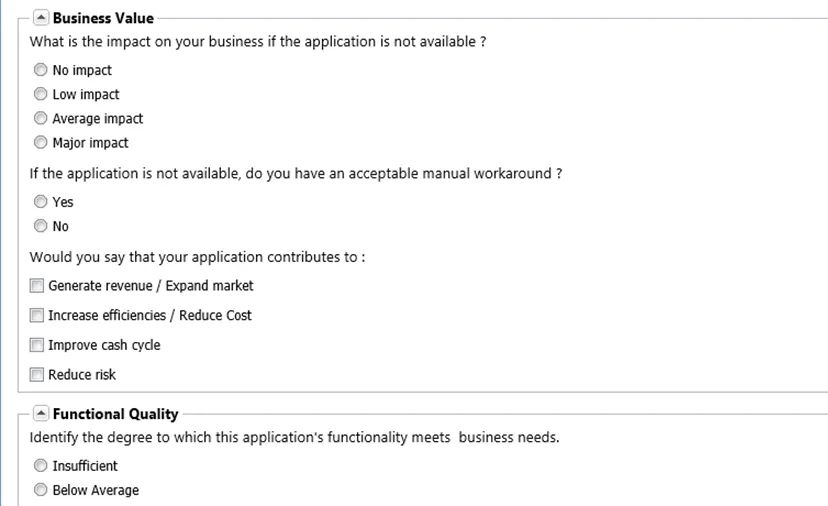
Submit questionnaires to company and IT owners to evaluate their applications.
C. Rank applications
Rank applications are made by consolidating scores and cross-referencing KPIs. This analysis ensures that the most important investments and resources are focused on the most critical applications and become the first recommendations for improving the portfolio.
Applications can be ranked into four categories:
- Eliminate: Applications with little value to the organization or impact on the business, such as those that are rarely used, not critical, replaceable by any existing application, or have high maintenance costs
- Tolerate: Applications with functional shortcomings and low business value but no technical issues or low maintenance costs.
- Modernize: Applications adding real value to the business but with poor operational performance –failing to meet technological standards, requiring re-engineering the application platform, or needing a code review (also the case for candidates to be moved to the cloud)
- Invest: High value for the business or high technical efficiency
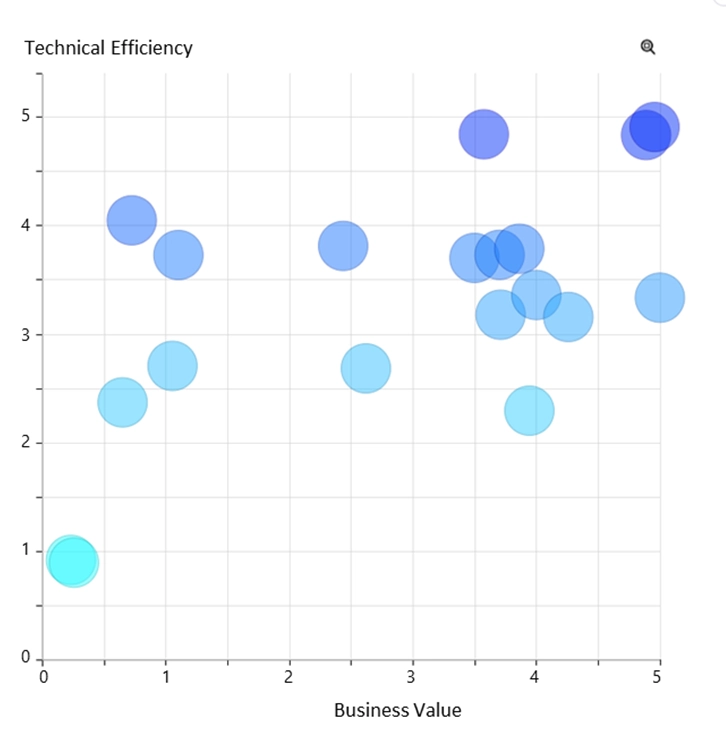
Rank applications and view candidates for rationalization
3rd step: Transform the application portfolio to reduce costs and increase flexibility
The last step of the process is to initiate and prioritize the transformation projects based on the identified applications to be removed or modernized. An essential deliverable is a business case that explains why the project should be done, how it supports business objectives, the related costs, a timeline, and possible risks because it enables decision-makers to make informed decisions.
Projects are prioritized based on their alignment with the business objectives and criteria. Once projects have been prioritized, they can be put in a timetable, forming the IT roadmap. With a clear IT roadmap, IT leaders can comprehensively view future IT modernization projects and plan resources and budgets accordingly.
A. Create rationalization projects (retirement, modernizing)
Through the assessment of the application portfolio, rationalization projects have been identified. The related projects must now be created as a first step to transform the application landscape.
- Create an IT portfolio of potential transformation projects based on identifying applications to be removed or modernized.
- Build a business case stating the benefits of operational performance and cost reduction.
- Link projects to business capabilities to assess the project's impact on the business and strategic objectives.
- Understand the impact of retiring an application from the portfolio by monitoring data flows between applications and removed functionalities.
B. Prioritize rationalization projects using what-if scenarios
Because all tasks can not be performed simultaneously, it is essential to prioritize them first. The prioritization can be performed based on the criteria you have defined. It is also recommended that a what-if scenario analysis be performed by combining multiple projects to prioritize the best mix of projects.
- Prioritize projects based on various factors, such as financial (ROI, initial investment), resources, deadlines, risks, and strategic alignment.
- Build what-if scenarios based on a mix of different projects.
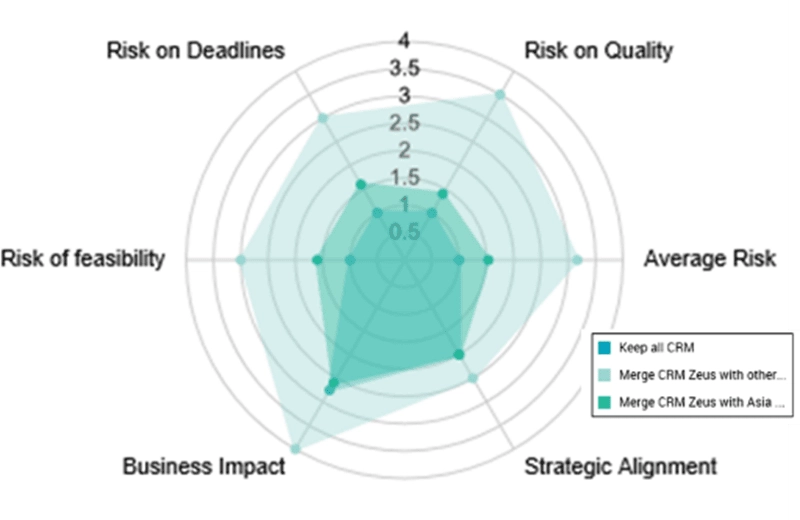 Compare and prioritize transformation scenarios based on multiple criteria.
Compare and prioritize transformation scenarios based on multiple criteria.
- Build an IT roadmap that includes the planned transformation projects.
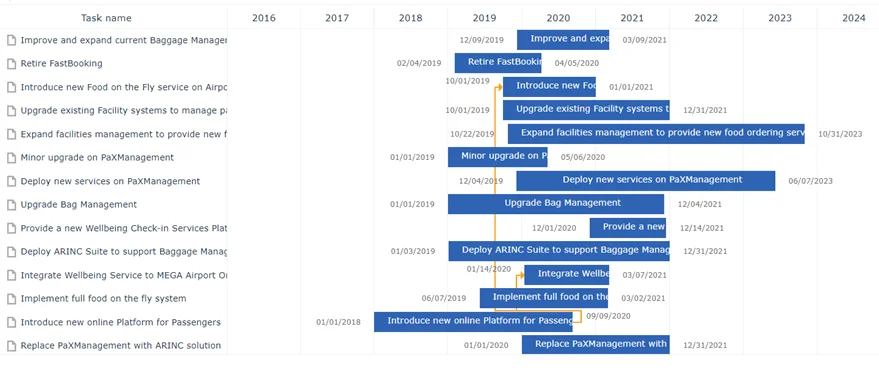 Create an IT roadmap encompassing current and future transformation projects.
Create an IT roadmap encompassing current and future transformation projects.
Application Portfolio Management Best Practices to Achieve Optimal Results
Critical Strategies for Optimizing Your App Portfolio:
- Avoid trying to do too much too soon – a steady and measured approach to setting up Portfolio Management and broader Enterprise Architecture practice – it is essential to take the wider stakeholder community along the journey to help them understand as maturity increases over time.
- Establish a core APM team and set clear roles and responsibilities
- Set up an executive board that defines and monitors the inventory, sets technology standards, and identifies significant business or technology changes that could impact the application portfolio and transformation plans
- Ensure accurate data is being populated and is updated regularly
- Avoid integrating with other solutions too soon, namely CMDB, Service Manager, and Discovery Tools (SCCM, DDMI).
- Focus on crucial data metrics first, and expand to enhance analysis as necessary.
- Ensure KPIs are relevant to operational and strategic goals
- Set quantifiable objectives, e.g., a 10% reduction in application maintenance costs per year
- Use dashboards suited for each stakeholder, such as cost reports for CIOs and portfolio assessments for portfolio managers.
- Implement a communication plan sharing the vision with the broader stakeholder community.
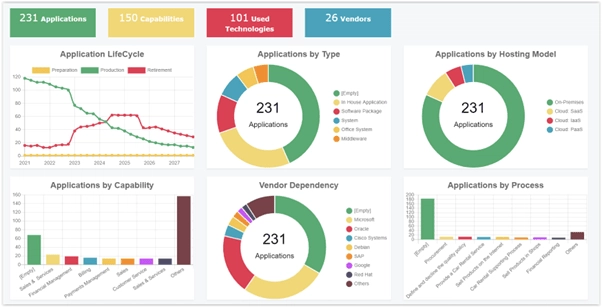
Use dashboards to monitor critical indicators such as costs, application by status (in production, retired), and application inventory completion percentage.
Key learnings about effective Application portfolio management
APM is not a simple inventory; it's a single source of truth where applications are described from multiple perspectives, providing a comprehensive understanding of the organization's IT landscape. Indeed, because of this extra visibility, IT leaders can identify the applications to be removed or modernized by performing impact analyses and sending questionnaires to the different organizational stakeholders.
An application portfolio management (APM) practice will help IT leaders maximize their application portfolio governance while ensuring IT systems are ready to embrace new business projects. It will also help organizations regain control of their application landscape, increasing agility and reducing costs.
How Can HOPEX Assist in Application Portfolio Management?
Exploring Cloud Migration Options
HOPEX offers a range of analyses providing intelligent recommendations for cloud migration that can help organizations effectively manage their application portfolio. Organizations can achieve greater scalability, flexibility, and cost savings by migrating applications to the cloud.
Leveraging HOPEX Services for Rationalization
Organizations can leverage HOPEX services, such as HOPEX AI-Driven APM, and HOPEX Smart Analysis, to assess their application portfolio, plan their migration strategy, and streamline the rationalization process.
Maximizing Business Value with HOPEX
HOPEX provides a wide range of services and solutions that enable organizations to maximize their business value through application portfolio management. By leveraging HOPEX's capabilities, organizations can optimize their application portfolio, reduce IT costs, enhance security, and improve overall operational efficiency.
Steps to select an application portfolio management tool

In conclusion, application portfolio management is an invaluable tool for any organization. It assists with resource allocation optimization, alignment of strategic goals, and improvement of development processes.
Most importantly, it gives decision-makers a clear picture of the application landscape to best utilize resources and improve performance. With this information, organizations can make sound decisions that will benefit their business for years.
Increase visibility and rationalize your IT portfolio with APM
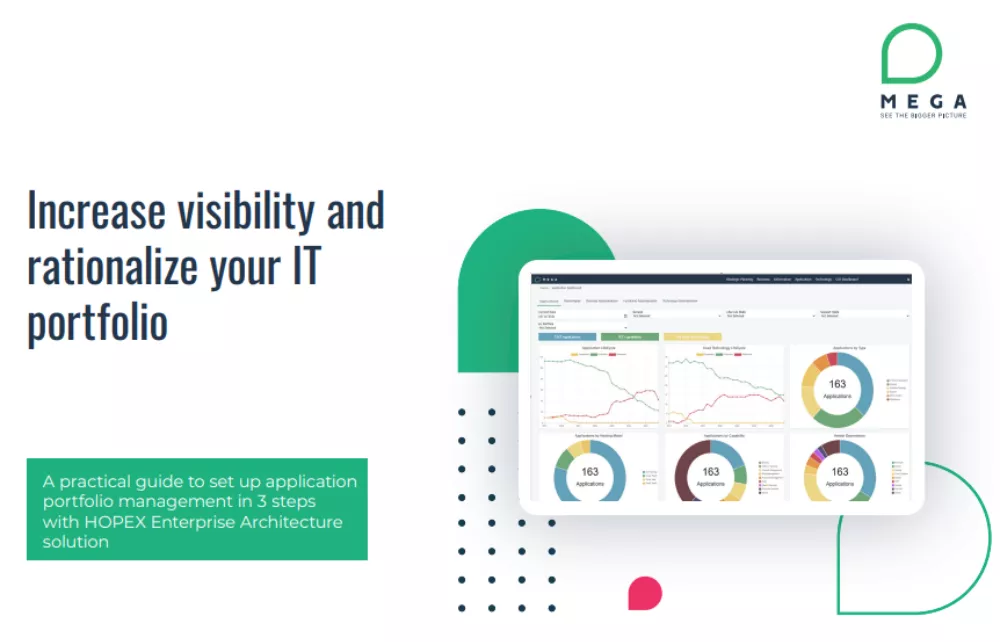
Get an effective methodology to set up and achieve a successful application rationalization initiative.
Enterprise Architecture Related Content
Shift from a documentation tool to an operational tool and accelerate business transformation
MEGA HOPEX for Enterprise Architecture
Request a demonstration of HOPEX for EA, and see how you can have immediate value of your projects.

The Most Detailed, Up-to-Date Enterprise Architecture Repository

The Most Detailed, Up-to-Date Enterprise Architecture Repository
According to McKinsey, 75% of North American and European executives expect increased investment in new technologies through 2024. As organizations invest more in digitization, decision-making must be based on quality data and information that is readily accessible. Enterprise data quality is rooted in a strong and well-maintained Enterprise Architecture (EA) repository that uses discovery to save time and increase quality.
Enterprise Architecture repository Definition
Enterprise Architecture repository is a term that describes a category of tools used to document and maintain the many components of an organization's IT architecture.
The repository is a central storage place for all architectural artifacts, such as frameworks, models, and patterns. Organizations can create more efficient designs by using a repository to store this data by taking advantage of reusable components.
Access to these elements in one place allows users to quickly assess their current architectures against new business requirements or technological advances.
What is an EA artifact repository?
An EA repository is a collection of artifacts that describes an organization's current and target IT landscape. It is intended to provide a centralized place to store and retrieve architectural artifacts. An EA repository should have the key logical components of the architecture metamodel, domains, principles, capabilities, governance documents, and reference library.
Organizations benefit from having a clear and documented approach or framework to conduct EA projects, including artifact templates, capability maps, and more. It stores the “as-is” architecture so gap analyses can be done to build “to-be” architectures and help identify opportunities to shorten time-to-market, reduce costs, and identify operational and technology improvements.
About Open-source enterprise architecture repository
There are many online repositories for software applications, including EA tools. A repository is simply a location where software is stored and can be accessed by users. Many repositories are open source, meaning anyone can contribute to and improve the software. The benefits of using a repository include accessing the latest software versions, trying out new features, and getting support from other users.
Open-source enterprise architecture (EA) repositories are invaluable tools for organizations looking to map IT projects, analyze business processes, and understand their relationships. An EA repository stores all related data in a single location.
This makes it easy to access data quickly when making decisions about new solutions or existing systems. Additionally, open-source repositories provide an opportunity to collaborate with peers who may have similar technical goals and objectives. This collaboration can help ensure that projects remain on track and that best practices are utilized throughout any project's lifecycle.
In addition to providing a platform for collaboration, an open-source EA repository also offers numerous features designed to streamline the process of documenting and organizing data associated with individual projects.
Architecture repository management
With all these components, getting the right pieces of information into the EA repository is no small undertaking, and keeping it updated (is critical for EA's success). Enterprise architects are drowning, trying to keep up with data accuracy, unable to reach the finish line as companies are dynamic and ever-evolving. Thus, the finish line keeps moving further.
This frustration is what architects mean when they talk about “death-by-repository.” In this scenario, EAs spend all their time trying to keep an "as-is" architecture up-to-date and, thus, do not have the availability to practice "to-be" architecture focused on business outcomes.
Architects who build and maintain an EA repository may manually import spreadsheets from Excel, CMDB, etc. Of course, manual takes a lot of time and is prone to error. While building a shared repository from scratch is possible, this can become time-consuming, and EAs risk falling behind.
Further to this point, the repository's design needs specific consideration, given that many people using the repository won't have everyday knowledge of where and how to find data. With proper tooling, however, there are easier ways EAs can begin to populate and design the EA repository.
Benefits of EA repository management
Death-by-repository fears are eliminated with discovery and connectors that reach across technologies, creating a common language. At its very core, the purpose of an EA repository is to drive connectedness to enable shared insights and overviews of relationships and interdependencies.
Reducing the friction of updating an EA repository benefits the company with more accurate data for stakeholder decision-making. It allows enterprise architects to do other, more value-oriented projects supporting business outcomes. Further, on average, developers spend only 5% of their time writing new code, 20% modifying the legacy code, and up to 60% understanding the existing code. Reducing time and manual work will allow developers and architects to focus on “to-be” future scenarios.
Some examples of different types of EA discovery
Enterprise Architecture deals with many concepts, including applications, technologies, processes, and data. To facilitate the population of an EA repository, there are four types of discovery to build, manage, and optimize information that can save considerable time and costs – and increase the quality of data and decision-making.
- Application discovery is a process through which applications installed and used throughout an enterprise are identified and collected. It provides visibility into server activity, collecting and presenting configuration, usage, and behavior data from servers, allowing one to get a total picture of the server workload.
Application discovery can reduce risk during code modernization by helping to understand the structure and interdependencies of legacy applications. It creates an inventory of all technical assets, which can help improve maintenance and operations, and delivers a strategy for future-state IT and modernization. Application discovery helps enterprise architects understand and manage metadata associated with each application, which is used to build an EA repository. - Cloud discovery automatically discovers all cloud instances spanning applications, databases, and related services running at a given time. As organizations continue to increase cloud usage, it is essential to understand the enterprise’s cloud footprint to allow security and auditing functions to know where and how to manage rogue and unmanaged deployments and identify shadow IT to reduce risk exposure.
Cloud discovery is vital in helping enterprises struggling to manage their multi- and hybrid cloud instances by enabling enhanced visibility, improved optimization, and reduced risk to maximize return on cloud investments. Cloud discovery helps enterprise architects and technology innovation leaders understand their cloud footprint and where/ how to manage potential gaps. - Process mining transforms data into event logs and then creates visualizations of the end-to-end process and insightful analyses, allowing you to compare what was designed with the actual process. It uses event logs to show what people, machines, and organizations are doing and provides insights on improving and addressing performance, bottlenecks, and compliance breakdowns. Process mining helps enterprise architects and technology innovation leaders understand operations and performance to optimize processes.
- In IT, data discovery is an exercise that allows a company to find its data stored in databases, build a data catalog and an enterprise glossary, and model the data architecture. Data discovery consists of collecting data from various sources by detecting patterns and outliers, which allows consolidation of the company's situation. This exposure allows architects to build a data dictionary, create an enterprise glossary, and design data models. They can also perform data lineage analysis and ensure data compliance. Data discovery helps enterprise architects and technology innovation leaders visually understand where data is located and how it is leveraged within the organization.
Find out about the Application Portfolio Management.
Repository structure: APIs and Connectors used by Enterprise Architecture tools
Many tools are available to help enterprise architects design and manage their systems. Many of these tools use APIs and connectors to allow for integration with other systems.
API stands for “Application Programming Interface.” An API is a set of rules and protocols that allow software components to interact with each other. Connectors are software components that provide a connection between two or more applications.
There are two ways to connect access points and thus share data through
EA tools can use APIs and connectors to databases, web services, and other applications to exchange data and perform various tasks. For example, a tool might use an API to retrieve data from a database and then use a connector to send that data to another application for further processing.
- APIs. The code governs the access point(s) for the server. This is especially useful as the API allows one to continuously query an application, get that data, and view or use it in another application.
- Connectors are the pieces that connect to the API and pass that data to the next message processor as a data stream. A Connector is for an application, and a VPN is for a Network. They should exist only for proprietary applications that cannot expose services as APIs.
An EA tool with a dynamic, connected repository provides the ability to browse and drill down on relevant details to enable architects and developers to conduct impact analyses and plan migration projects. Tools that use APIs and Connectors to conduct discovery are handy as they allow enterprise architects to start providing value on Day One.
Third-party integrations or connections with CMDBs and other solutions from software providers like ServiceNow, Flexera, SAP, Salesforce, and Microsoft, or with structured and unstructured databases such as MongoDB; and many other technologies help EAs build a repository instantaneously and maintain it with quality information.
The possibilities are almost endless when an EA tool uses APIs and Connectors to connect and build upon data. Since many different types of APIs and connectors are available, each has its strengths and weaknesses. Choosing the right ones for your needs can be challenging, but doing so is essential for ensuring that your EA tools work effectively.
Discovery saves time and increases quality.
Discovery is the population and maintenance of applications, processes, and data, so companies can manage and optimize their EA repository and feel confident about its accuracy and quality. It uses open APIs, integrations, and connectors that fetch the right data. Discovery can also be associated with artificial intelligence to detect patterns and perform advanced analyses.
The benefits are tangible:
- It quickly populates the EA repository by connecting to operational data.
- It ensures quick time-to-value, increases data accuracy, and can be relied upon for decision-making.
- Reports and analytics can be created and leveraged instantly.
- Architects can use these insights to drive business intelligence and design “to be” states - and not have to spend time on "as is" current state, as it's already done.
- EA's perceived value inherently moves from noisy to influential.
In conclusion, an enterprise architecture repository is an invaluable tool for any organization, large or small. It can help streamline workflows and facilitate collaboration across departments. It also makes it easy to store and organize essential data that may be needed. Additionally, with a repository, organizations can easily track changes to their architecture and better understand their impact on their operations.
The discovery not only speeds up the population of the EA repository but also frees up enterprise architects to focus on business outcomes that can support agile delivery and digitization. Ultimately, it ensures the EA repository is a single source of truth for IT standards that can be relied upon by users and stakeholders to make smarter, faster decisions.
FAQs
An EA repository is a collection of software tools and components that support implementing An EA practice. The repository provides a common place for storing and sharing EA artifacts, such as models, templates, and reference architectures. It also enables collaboration among EA practitioners and facilitates the adoption of best practices.
An EA repository is a valuable tool for IT organizations because it provides a centralized location for storing and managing enterprise architecture artifacts. Having an EA repository can help improve communication and collaboration between architects, reduce duplication of effort, and make tracking and managing changes easier.
Overcome digital transformation challenges with Enterprise Architecture
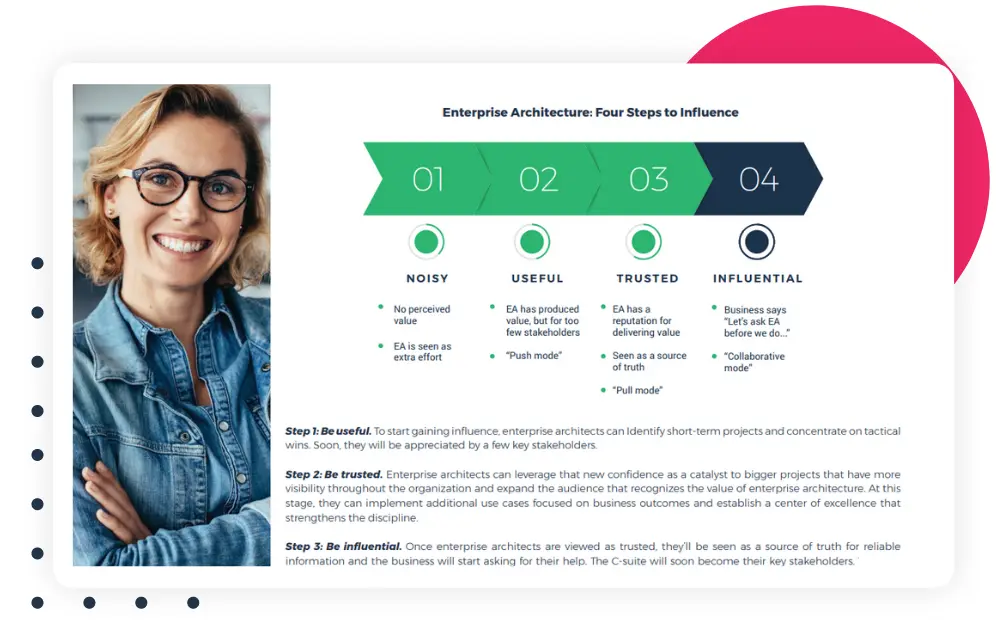
Discover how EA helps you tackle digital transformation challenges and optimize all areas of business.
Enterprise Architecture Related Content
Shift from a documentation tool to an operational tool and accelerate business transformation
MEGA HOPEX for Enterprise Architecture
Request a demonstration of HOPEX for EA, and see how you can have immediate value of your projects.

Enterprise Architecture Frameworks, Origins, and Evolution

Enterprise Architecture Frameworks, Origins, and Evolution
Businesses have always been complex. Producing something people want at a price they are willing to pay may sound simple, but acquiring resources, ensuring constant availability, and creating a quality product. Marketing that product, collecting payment, reporting, and complying with whatever regulations are relevant are individually complex.
Assemble these actions into a chain, and the complexity increases exponentially. What happens when digital disruption, market fluidity, cybersecurity, global reach, and ever-changing regulatory requirements are introduced?
All this complexity, risk, and opportunity must be intimately understood regarding business. That is precisely how enterprise architecture came to be.
Enterprise Architecture (EA) evolved from the need to manage complexity in organizing the business, or enterprise, through comprehensive perspectives that provided visibility into how the enterprise components were connected and co-operated. The problem with enterprise architecture as a concept was that there needed to be some way to organize, classify or catalog these components.
This taxonomy, or ontology, must be comprehensive, scalable, and, more importantly, portable. In other words, businesses didn't want to completely "reinvent the wheel" every time there was a change in the market, the operating model, or even a change in employees.
Digital transformation, technology disruption, and business agility in enterprises today have forced frameworks and enterprise architecture to evolve.
What is an Enterprise Architecture Framework?
An enterprise architecture framework defines an enterprise's structure, governance, and operations.
It is a tool for enterprise architects to plan and execute enterprise-wide digital transformation initiatives and guides architecture development over time.
The main components of an enterprise architecture framework are:
- A business model that outlines the goals and objectives of the enterprise
- A set of principles that guide decision-making
- A set of architectural patterns that guide how to design and implement solutions
- A set of tools and techniques for managing enterprise architecture.
The framework also includes for each architecture layer the following:
- A clear statement of the problem to be addressed.
- An identification of the key stakeholders.
- An overview of possible solutions.
- Evaluate the costs, benefits, and risks associated with each answer.
For instance, the business architecture framework includes the description of the object employing terms and concepts that define the business.
- A taxonomy that categorizes those terms or concepts
- A method that describes the use of that taxonomy
- A shared vocabulary, enablers, or capabilities that define how these concepts and methods are implemented
- And objectives or results of those implementations.
The management toolset includes tools, processes, components, and key performance indicators (KPIs). That allows the enterprise to be represented in comprehensive and tangible visions, allowing it to see itself as it is, as it could be, and how it is progressing toward the envisioned future state.
The framework provides the mechanism and rules for how the components are connected and interact and how these connections are presented to decision-makers.
The framework ensures consistency and reliability so that decision-makers know how to use this information and have confidence in the validity of the data.
Benefits of an Enterprise Architecture Framework
The benefits of using such a framework include the following:
- Improved communication and collaboration among stakeholders
- Better alignment of IT with business goals
- More efficient and effective use of resources
- Reduced risk and increased agility
- Improved decision-making and
- Improved governance.
A comparison of Enterprise Architecture Frameworks
There are four main enterprise architecture frameworks: The Open Group Architecture Framework (TOGAF), Zachman Framework, the Software Engineering Institute's Capability Maturity Model Integration (CMMI), and DoDAF.
Frameworks tend to favor an academic approach that is not sufficiently focused on delivering results quickly in line with business expectations.
In many organizations, EA teams focusing on specific use cases such as application portfolio rationalization, cloud migration, or introducing new products/services are often more recognized than those that try to apply a framework academically.
With the need for an EA, framework understood, the question becomes: "What Enterprise Architecture framework to adopt"? Understanding the evolution of EA frameworks will provide context for better decision-making.
Types of enterprise architecture framework
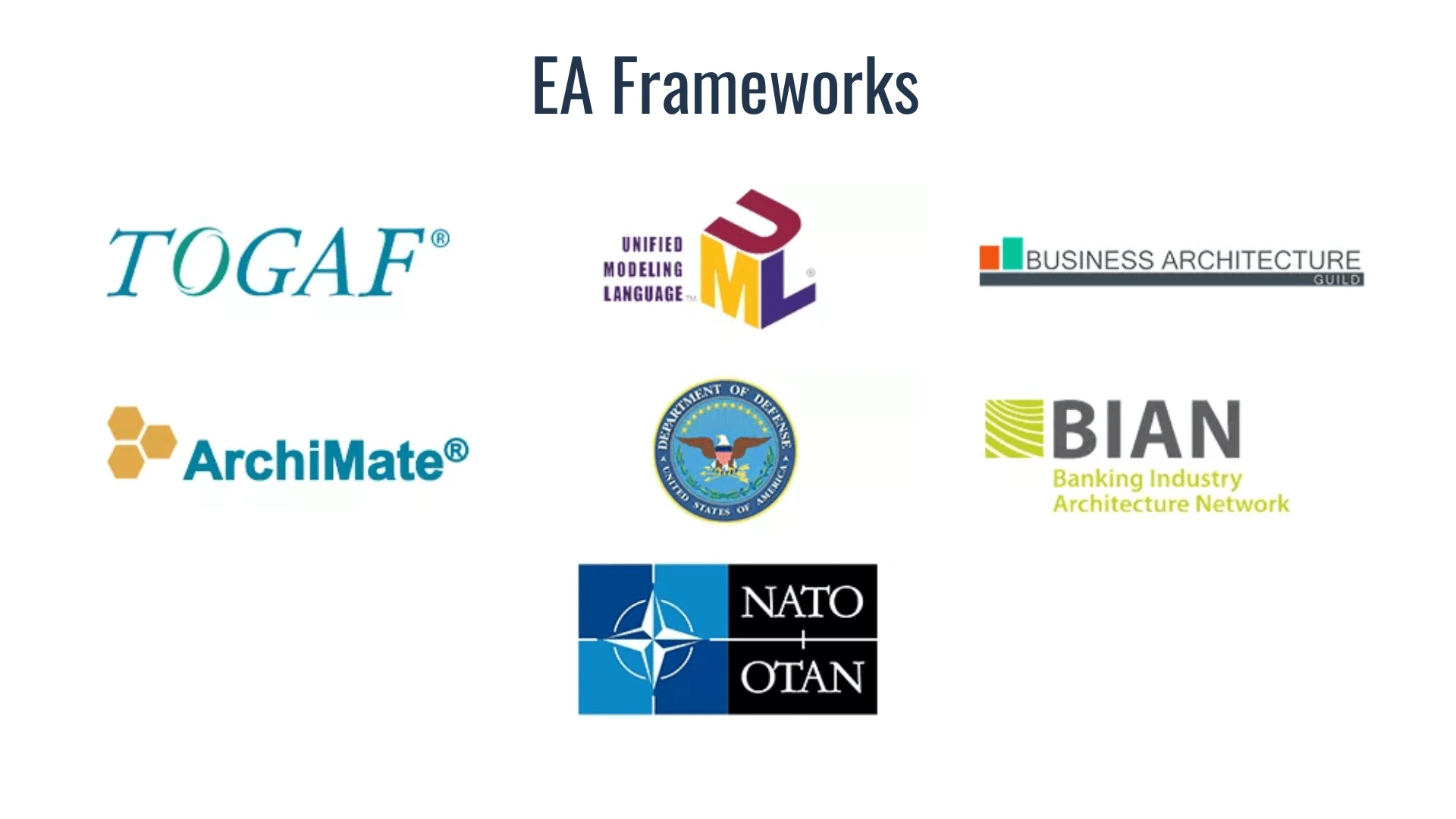
There are various enterprise architecture frameworks, such as Zachman Framework, TOGAF, FEAF, and DoDAF. The Zachman Framework is a classification system that provides comprehensive coverage of all aspects of an enterprise. TOGAF is an open-source framework that helps organizations develop and use an enterprise architecture. FEAF helps organizations develop a high-level view of their IT system, while DoDAF provides the structure for organizing data into actionable information. All these frameworks can be used together or separately to optimize the performance of an organization’s IT systems.
Zachman Framework: The Godfather of Enterprise Architecture
When the topic of EA frameworks comes up, all EAs pay homage to the pioneer of EA frameworks, John Zachman, who developed the Zachman Framework in 1987 while working at IBM*. The Zachman Framework is more of an ontology than a framework, but it is the go-to for classifying descriptive representations (models) that constitute the enterprise architecture.
The classification uses the six primitives (who, what, why, when, where, and how) to describe these models.
Later, in 1990, John Zachman teamed up with Samuel Holcman, and they founded the Zachman Institute for Framework Advancement; in 2008, this institute was dissolved.
Samuel Holcman went on to find the Enterprise and Business Architecture Center of Excellence. John Zachman, in 2012, acquired the FEAC Institute, where he incorporated executives from the Zachman Institute, the Federal Enterprise Architecture Framework (FEAF), the Finnish Enterprise Architecture Framework (FEAR), and the Department of Defense Architecture Framework (DODAF / DOD Architecture framework).
What is TOGAF Framework?
Over the last thirty years, one Enterprise Architecture framework has become the most popular EA framework. That framework is The Open Group Architecture Framework or TOGAF. 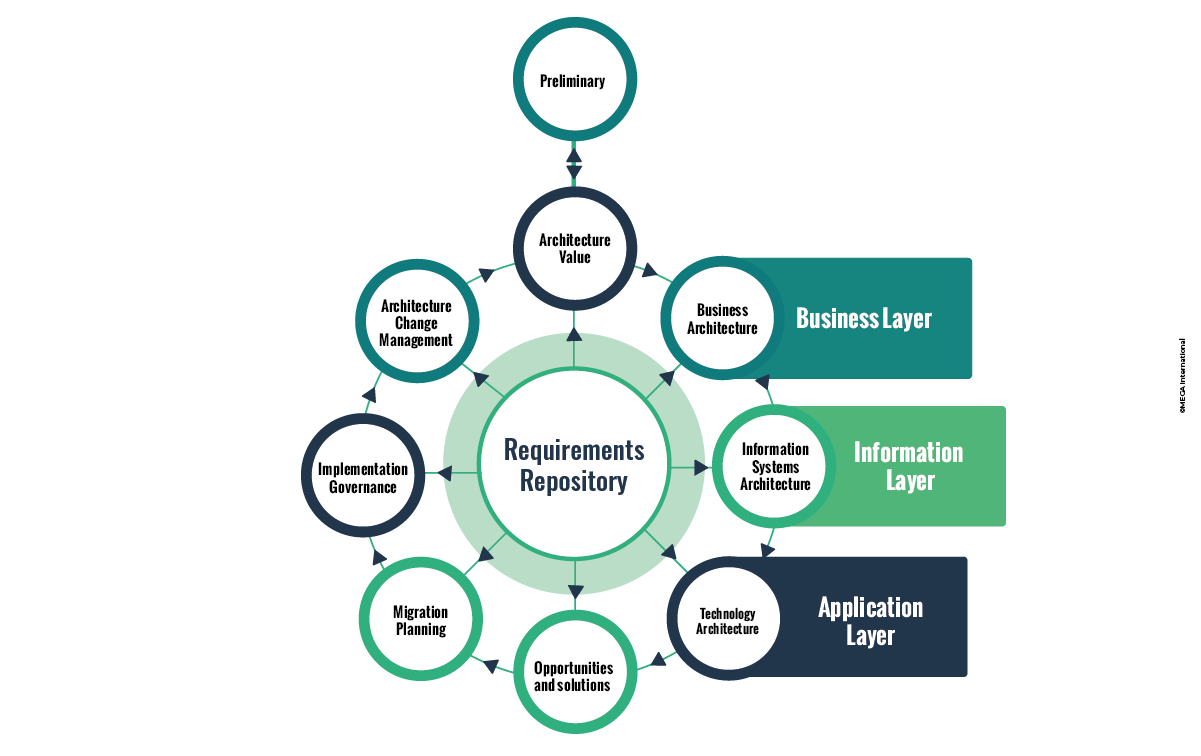
Structure - TOGAF Architecture Development Method
The Open Group was founded in 1996 to form a consortium that seeks to enable the achievement of business goals through the development of open, vendor-neutral technology standards.
The Open Group grew to over 650 active members, who create standards for computer engineering. Through this effort, they developed ArchiMate, a model that breaks down systems into dynamic structures, passive structures, or behaviors. ArchiMate provides a common language for describing, analyzing, and visualizing the relationships between the elements of an enterprise architecture.
Different versions of The Open Group Architecture Framework
TOGAF is currently in its 10th Edition, but the ADM, or Architecture Development Model, is the most widely recognizable feature of The Open Group's TOGAF. This model uses a cyclical approach to the development of architecture.
The cycle consists of developing a vision, defining the business, application, data, and technology domains, planning, managing change, deploying, and governing the architecture while maintaining the requirements as a central focal point. The ADM outlines and classifies specific deliverables associated with each of the phases.
Other examples of common frameworks
There are many Enterprise Architecture Frameworks, but some popular frameworks over time include:
- Spewak Model: developed by Steven Spewak in 1992. Spewak defined EA planning as the process of defining architectures to use the information to support the business and the plan for implementing those architectures. Spewak focused on the business implications of architecture planning. The business mission was the primary driver, followed by the data required, applications that use the data, and the technology used to implement the applications.
- Merise Model – The French Merise model defines a conceptual IT project analysis, design, and management model. Merise was widely used in the 1970s and 1980s to support the computerization of businesses. Merise treats data ad processes in three stages: conceptual, logical, and physical. Process views also follow three phases: conceptual, organizational, and operational. These stages in the modeling processes are paralleled by the stages of the lifecycle: strategic planning, preliminary study, detailed study, development, implementation, and maintenance. Merise is a model based on entity-relationship.
- Unified Modeling Language (UML) – UML was developed in 1994-1995 by Grady Booch, Ivar Jacobson, and James Rumbaugh. UML was adopted by the Object Management Group in 1997 and published by the International Organization of Standards (ISO) as an approved ISO standard in 2005. UML is a general-purpose, developmental modeling language that aims toward a standard way to visualize the design of a system.
- MEGA EA Grid – MEGA has developed its framework of concepts known as the EA Grid, which preserves the Merise system and declines it in the different layers of the company. The UAF model also inspires the EA Grid.
Many other frameworks exist, such as DODAF, The Common Approach, FEAF, MODAF, DNDAF, NAF, and UAF. Each has a specific orientation and is used by organizations to accomplish a standardized, consistent approach to developing an enterprise architecture consumable by the business or organizations they support.
Specific Business Architecture Frameworks
Every industry vertical has its specificities, and not surprisingly, some frameworks address EA for these. ACORD (Association for Cooperative Operations Research and Development) is insurance industry-specific.
BIAN (Banking Industry Architecture Network) is specific to banking, MIMOSA for manufacturing, and so on.
One organization focused specifically on business architecture and the development of reference models for common areas that span all industries and industry-specific reference models is the Business Architecture Guild (The Guild).
The Guild developed the Business Architecture Body of Knowledge (BIZBOK), which provides a general and basic framework for business architecture. These industry-specific reference models are easy to implement.
Why do we need Enterprise Architecture Frameworks?
Creating an enterprise architecture is challenging but could be facilitated using an enterprise architecture framework.
However, very few companies deploy a complete EA framework. Due to the exhaustive nature of these frameworks, implementing a comprehensive framework is expensive and intensive. Not only must the framework be implemented, but it also requires maintenance.
For these reasons, most companies adopt a framework, or even cobble together parts of different frameworks, to meet their business's needs and provide value. EA frameworks are used more than guidelines instead of rigorous standards and practices.
Selecting the right framework concepts or techniques ensures that the company will get value from enterprise architecture and that practitioners will utilize the framework. Understanding the context behind EA frameworks is essential in helping to make that decision.
Understanding how Enterprise Architecture frameworks evolved to get to where they are now, and learning their respective areas of success and failure, will provide the information that will allow businesses to adopt or adapt an EA framework. And it will provide the complete visibility needed to help the company manage the complexity inherent in business today.
Moving to an Agile Enterprise Architecture
One of the most common complaints of the traditional enterprise architecture function is that it does not keep up with the pace of change. It does not facilitate agility. The development and adoption of the Agile methodology have forced enterprise architecture to change its approach more than any other force in the business.
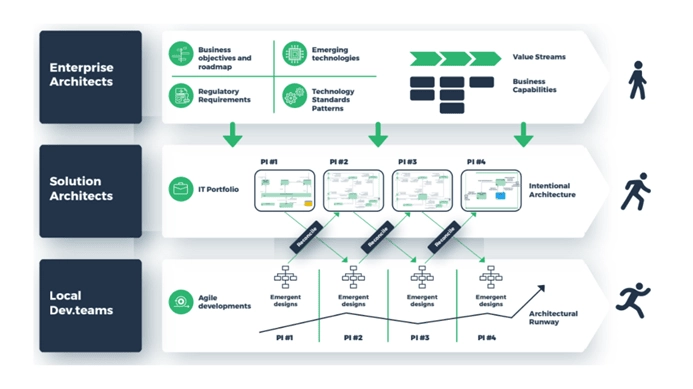
Businesses must be able to change course rapidly, account for technological disruption, develop new capabilities, or enhance the customer experience of existing capabilities.
Fortunately, recent technological advancements have enabled the automation of architecture processes. Enterprise architects can now focus on exploring emerging technologies and innovation, build reference architectures, and help set and achieve strategic business objectives.
To do this, enterprise architects must understand more than just technology. They must understand the business and how technology enables that business.
The Problem with Agile Methods
Agile methods solved some problems. Projects had very high failure rates. Either the stakeholders were not getting what they expected, or time to value was not keeping up with the pace of change in the marketplace.
Also, many projects experienced heavy technical debt, causing enormous downstream costs when technologies were no longer viable and had to be updated.
The results were inevitable immobility. Changing the organizational structure by breaking the pyramidal hierarchies and focusing on interactions between individuals more than on processes and tools could be more rapidly implemented, thus allowing rapid changes in direction and development of user-friendly functionality.
This organizational revolution did not come without risk. Small agile teams may be able to make rapid changes and adjust to meet changing requirements, but the absence of the traditional pyramidal structure means that the big picture is no longer seen.
The collection of teams loses the perspective of a common goal and iterates on details that no longer contribute to the value of the initial effort.
Scaled Agile framework
There is no argument against a need for agile thinking. Due to rapid technological advancement, where barriers to entry of new products in the marketplace are virtually non-existent, and where market shares are frequently redistributed, there is a strong need for a variable adjustment.
This variable comes in the form of Agile @ Scale. One of the most popular examples of agile @ scale is SAFe (Scale Agile Framework). SAFe was designed in 2011 by Dean Leffingwell. This framework has shaken up traditional architecture.
Not only does SAFe integrate with architecture frameworks, but it also allows the application of the methodology to larger groups that can work effectively without dispersing and according to an overarching plan.
The purpose of SAFe is not to manage a project but to build a product. The product is decomposed into functionalities or capabilities instead of requirements. In this way, we achieve a faster feedback loop with the customer and avoid the costs of product release delays.
How do you Choose the proper enterprise architecture framework?
There is no one-size-fits-all answer to this question, as the best enterprise architecture framework for your organization will depend on several factors, including your specific business goals, the size and structure of your organization, and the existing IT infrastructure.
However, a few general tips can help you choose the proper framework for your needs:
- Do your research: Various enterprise architecture frameworks are available, so it's essential to research the different options before deciding.
- Consider your goals: What are you hoping to achieve with your enterprise architecture? Ensure that your chosen framework is well-suited to help you reach your goals.
- Consider your organization: The size and structure will impact the feasibility of implementing a particular framework. Make sure to take these factors into account when making your decision.
In conclusion, an enterprise architecture framework is essential for any company looking to improve its systems and processes. It provides a roadmap of the organization's current state, future objectives, and the steps to get there. It also standardizes the design process and ensures that each system operates harmoniously with the rest of the enterprise. With an enterprise architecture framework, businesses can save time, money, and resources while improving efficiency.
MEGA HOPEX solutions, acclaimed by industry analysts, use a proven methodology based on standards, enterprise architecture framework, and best practices.
Achieve Business-IT Alignment with IT portfolio management methods
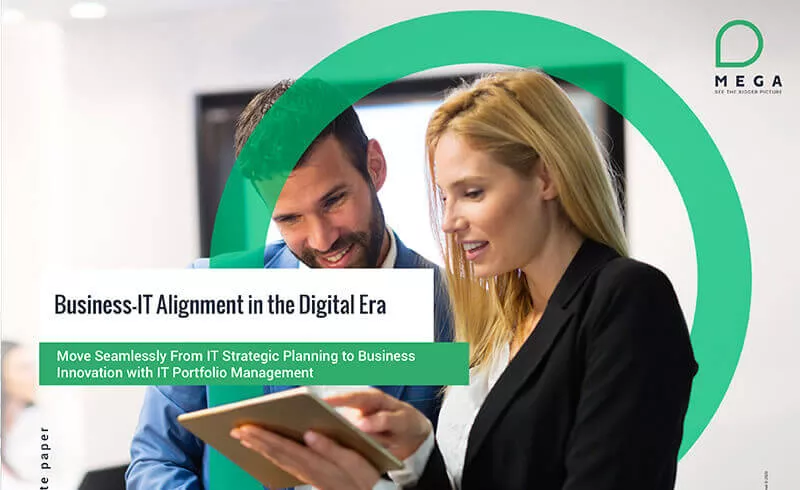
Provide key steps for ensuring an aligned business architecture and IT architecture.
Enterprise Architecture Related Content
Shift from a documentation tool to an operational tool and accelerate business transformation
MEGA HOPEX for Enterprise Architecture
Request a demonstration of HOPEX for EA, and see how you can have immediate value of your projects.

What is Enterprise Architecture (EA), and Why is it Important?

What is Enterprise Architecture (EA), and Why is it Important?
Enterprise architecture is a framework that helps businesses align their strategy, processes, and technology to achieve their goals. Essentially, it's a way to ensure that everyone is on the same page regarding the organization's vision and mission. Companies can improve communication, increase efficiency, and reduce costs by having a clear enterprise architecture. But it's for more than just big corporations - even small businesses can benefit from having a solid enterprise architecture in place. In this article, we'll define what enterprise architecture is and why it's crucial.
The business ecosystem is getting complex. Every organization must transform to stay competitive according to multiple changes: customer expectations, new competitors, emerging technologies, regulation changes, and any world disruption. Enterprise Architecture (EA) is critical to support this transformation despite its complexity. EA helps organizations integrate different departments, systems, and processes by incorporating industry standards. Next, we will explain how.
Definition of Enterprise Architecture
Enterprise Architecture (EA) is a practice that aims to align an organization's strategy and operating model. Enterprise Architecture outlines how an enterprise should organize and manage to achieve its objectives. As such, EA provides a blueprint to support the transformation of the enterprise - it is a journey and not a one-off project.
Why is enterprise architecture important?
Enterprise architecture is Critically vital for several reasons:
- It provides a common language and framework for businesses discussing IT initiatives. This common language allows different departments and business units to communicate more effectively with each other, which can help avoid costly misunderstandings.
- Enterprise architecture can help an organization align its IT investments with its business goals. By understanding how its various IT systems work together, an organization can ensure that its IT investments support its strategic objectives.
- Enterprise architecture can improve an organization's overall efficiency by helping it to identify and eliminate duplication and redundancy in its IT systems.
Purpose of enterprise architecture
EA aims to align business objectives with technology capabilities to achieve strategic goals. EA provides a holistic view of an organization's structure, processes, information systems, and technology infrastructure. The primary function of EA is to ensure that all the components of the enterprise, including business strategies, business processes, data architectures, and system architectures, are integrated, secure, and efficient.
By adopting EA, businesses can improve their decision-making, increase agility, reduce operational costs, and enhance their overall performance. EA also facilitates communication between different departments, providing a common language and framework for stakeholders to understand and collaborate on complex IT projects.
This approach can prevent duplication of IT systems or services that can potentially increase business costs, improve system resilience, and enhance agility. With enterprise architecture, digital transformation can be proactively and holistically led, leading to successful outcomes and fulfilling the desired business vision.
Therefore, organizations should prioritize enterprise architecture management to stay on track and achieve their digital transformation goals.
The Importance of Enterprise Architecture in Digital Transformation
Enterprise architecture is vital in guiding digital transformation efforts within an organization. It provides a detailed overview of the internal systems, processes, and data flows, enabling organizations to identify improvement areas and innovation opportunities.
By conducting thorough assessments of current IT infrastructures, enterprise architects can help identify gaps, redundancies, or inefficiencies that hinder digital transformation and recommend a roadmap for modernization. Moreover, enterprise architecture prevents duplication of IT systems or services that can potentially increase business costs, improve system resilience, and enhance agility.
Without enterprise architecture, a digital transformation journey can be disjointed and fail to meet business goals. Therefore, it is imperative for organizations undergoing digital transformation to prioritize enterprise architecture to ensure they stay on track and achieve the desired outcomes.
Key Components of Enterprise Architecture
EA provides methods to describe an entire organization's vision to analyze and design it, then plan and implement its evolution. 4 primary architecture layers ensure this completeness:
- Business architecture: This layer describes the company's strategy, the services offered, the organization, and the business capabilities required to deliver the services.
- Application architecture: This layer defines the enterprise's application portfolio, integration, and how these IT assets support the processes and services delivered.
- Information Architecture: This layer defines the enterprise's information requirements and data model and helps ensure data is managed to support business needs.
- Technology architecture: This layer identifies the technologies (software and hardware) that support the applications and data and understand how they are deployed.
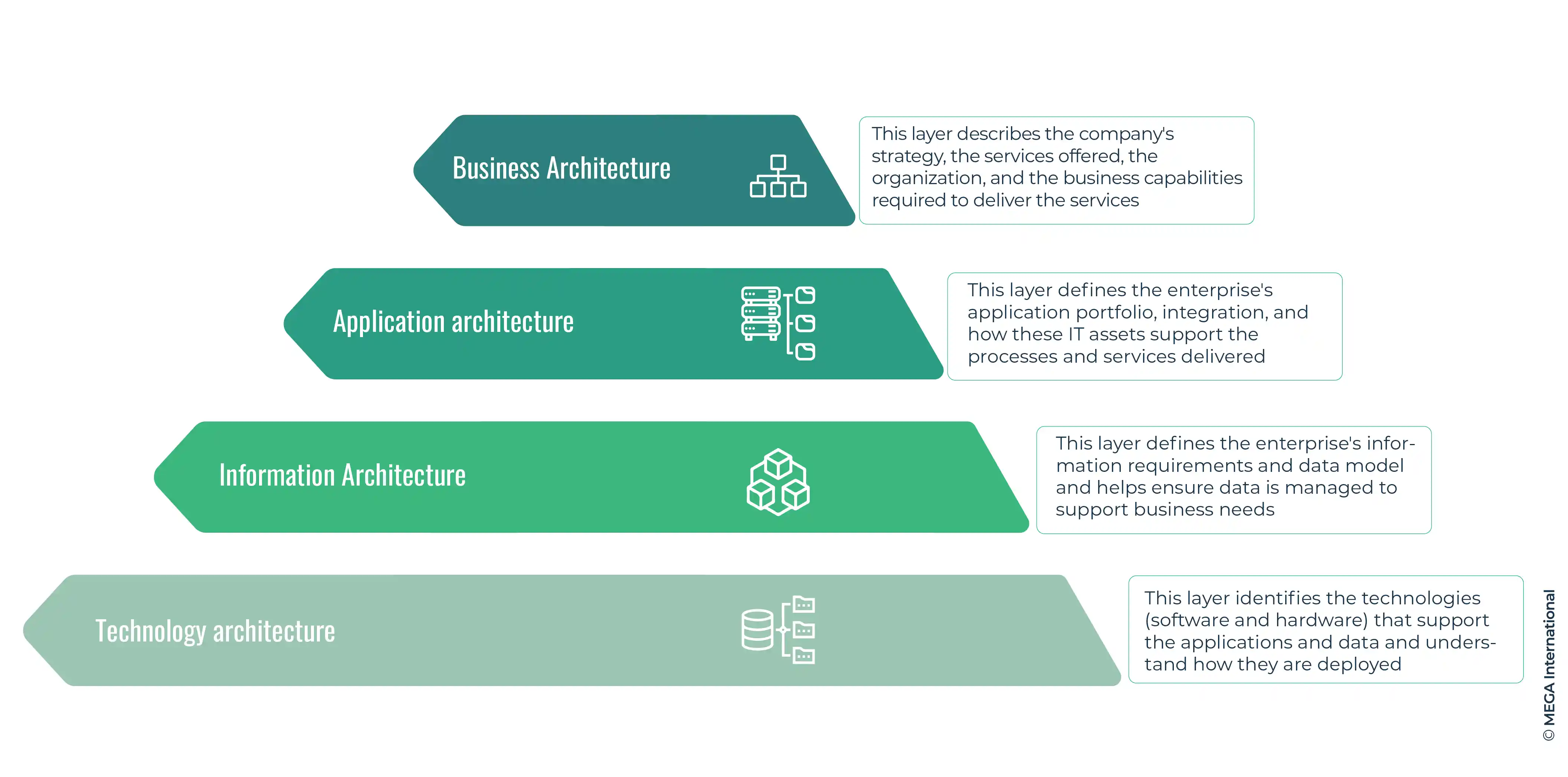
Each concept is, therefore, specific to a layer. Still, it can be linked to concepts from other layers (e.g., a business capability may be supported by one or several applications, each relying on numerous technologies), and precisely analyzing these relationships enables identifying the impact of change.
For example, what happens if a server deployed in the organization goes down? What would be the consequences for the business?
This impact analysis will help identify risks and anticipate problems, helping to design better and plan the company's transformation.
Learn about Elements of Business architecture vs. Enterprise Architecture.
Enterprise architecture benefits
EA is its ability to provide recommendations to business and IT teams to adapt current processes and IT assets, ensuring they are aligned with the company's strategy.
Enterprise Architecture tool makes it possible to implement actions to reduce the risks generated by these drifts and offers more concretely the following benefits:
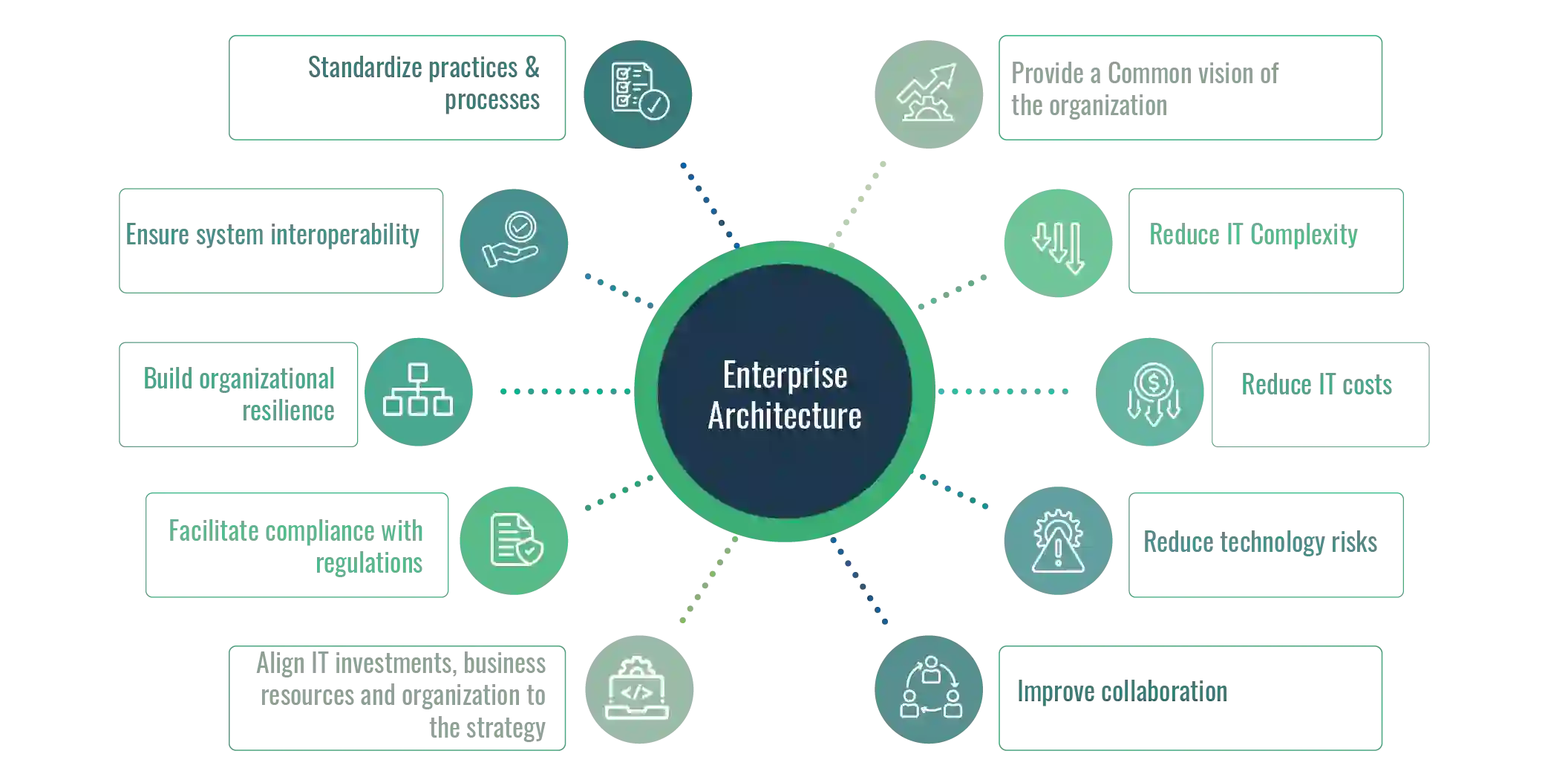
- Provide a shared vision of the organization.
- Reduce IT complexity and facilitate the evolution of Information Systems.
- Reduce IT costs by removing redundancies and breaking organizational silos.
- Improve collaboration between business and IT teams.
- Align IT investments, business resources, and organization to the company's strategy.
- Facilitate compliance with regulations.
- Build organizational resilience.
- Ensure system interoperability.
- Standardize practices and processes.
Enterprise Architect's Role
Enterprise architects analyze operating models (structures, processes, resources...) to ensure they effectively and efficiently align with business goals.
The role of enterprise architects is to ensure that these structures and processes are agile and durable, allowing them to adapt quickly and support significant changes. They usually report to the CIO (Chief Information Officer) or other IT managers and may work as CTO (Chief Technology Officer), software engineer, development manager, or CIO.
An undergraduate degree in computer science, information technology, or a related field, as well as at least ten years of experience in IT or a related field, are required to become an enterprise architect.
You should also have hands-on experience with computer systems, mainframes, and other architectural techniques. To succeed, enterprise architects must have various soft skills, including communication, problem-solving, critical thinking, leadership, and teamwork.
Enterprise architecture stakeholders and their concerns
As Enterprise Architecture aims to describe an organization's complexity, EA’s scope is vast. Depending on the intended objective, many organizational roles may be involved in the EA processes.
- Enterprise Architects: provides architecture services that transform the operating model to align with the strategy.
- Portfolio Managers: responsible for maintaining and rationalizing application or technology portfolios
- Business Architects: define business models and capability models, and ensure that value streams are aligned with customer expectations and journeys
- Solution Architects: design technology solutions to meet business needs, typically at the application, service, and infrastructure levels
- Security Architects: verify that newly designed architecture complies with the organization's security policy
- Business Analysts: refine and optimize processes for general improvements or regulatory reasons, as well as define candidates for automation
- Chief Data Officer/Information Architects: manage and design where data and information are used, moved, or stored across the enterprise and support intelligence, regulatory, privacy, and data science activities
- Risk/Compliance Managers: responsible for assessing risk exposure and regulatory compliance of the current or future state of the enterprise
CIO (Chief Information Officer) and CISO (Chief Information Security Officer) are often the organization's leading sponsors of Enterprise Architecture.
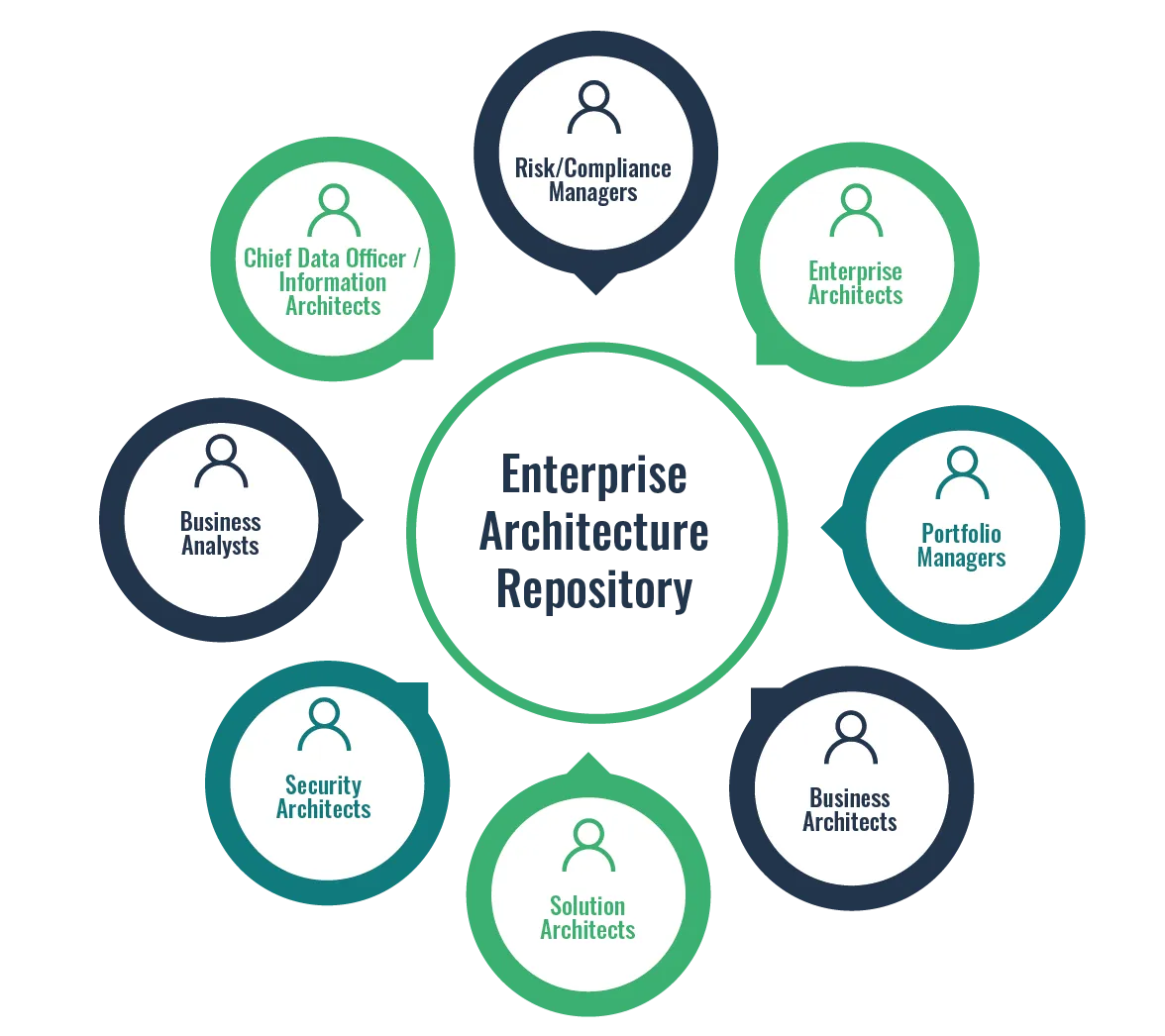
What enterprise architecture does in your role for IT operations?
For each of these roles, Enterprise Architecture provides answers to their specific questions:
(People with IT focus)
- Solution Architect: How should I integrate a new solution into the IT landscape? What are the authorized technologies in the company? Should I deploy this application in the cloud or on-premises?
- Security Architect: Does the new solution respect security principles? What are the threats and vulnerabilities of each application?
- Developer: Which microservices should I leverage? What are the current application integrations?
- CTO (Chief Technology Officer): What is the technology roadmap? What are the risks coming from technology obsolescence? How do I mitigate these risks?
- CIO: How can we prioritize our IT investments to support the company's strategic priorities? How should we transform our IT landscape? In which application should we invest? Which applications should be removed? What is the IT roadmap? What is the cost of our IT landscape, and how can we reduce IT costs?
(People with Business Focus)
- Business Analyst: Which applications support this process? How should we automate this process?
- Risk Officer: What are the risks to IT assets (cybersecurity, compliance)?
We must implement EA appropriately to get the correct answers to all these questions.
This implementation can be tedious without guidance, which is why Enterprise Architecture frameworks can help accelerate the performance of an Enterprise Architecture practice.
Enterprise architecture framework
Enterprise architecture frameworks are a set of structures, processes, and tools that support the management and implementation of an enterprise architecture. The framework ensures consistency and reliability; it can be a natural accelerator for people who want to set up an Enterprise Architecture practice quickly without spending too much time defining each concept and its relationships.
There are several EA frameworks, each with unique features that distinguish it from the others. Some of the most popular enterprise architecture frameworks include The Zachman Framework, The Open Group Architecture Framework (TOGAF), Federal Enterprise Architecture Framework (FEAF), and The Global Enterprise Architecture Organization (GEAO).
Each framework has a specific approach, methodology, and process to help organizations identify, design, and execute an effective enterprise architecture. Learn more about the enterprise architecture framework's principles and best practices.
Enterprise Architecture models and diagrams
EA aims to describe an organization's different perspectives to understand, analyze, and transform it.
Modeling is vital to explain this complexity and communicate it to all stakeholders. Modeling is necessary to understand complex systems from multiple perspectives; it is also a perfect solution to share with non-expert people.
Architecture relies on models and diagrams to address several key objectives:
For Enterprise Architecture:
- Business motivation model to represent the enterprise strategy and visualize enterprise objectives.
- Business Model Canvas to get a high-level, comprehensive view of the strategic items required to bring a product to market successfully
- Business capability maps to clearly understand the enterprise's capabilities and how IT assets support them.
- Customer journey map to understand how customers interact with the organization and their satisfaction level.
- Process/Value stream maps to visualize how products and services are delivered and analyze the value delivered to customers.
- Enterprise transformation roadmap and IT roadmap to visualize and communicate how business and IT projects are planned over time.
For Solution Architecture:
- Solution environment model to define the solution's integration into the existing IT landscape.
- Application deployment model to describe how technical components of an application must be deployed to avoid potential pitfalls
- Technical infrastructure map to define the technical infrastructure required to support the deployed solution
Use cases and examples for Enterprise Architecture
Enterprise Architecture's vast scope covers multiple use cases to help decision-makers manage changes.
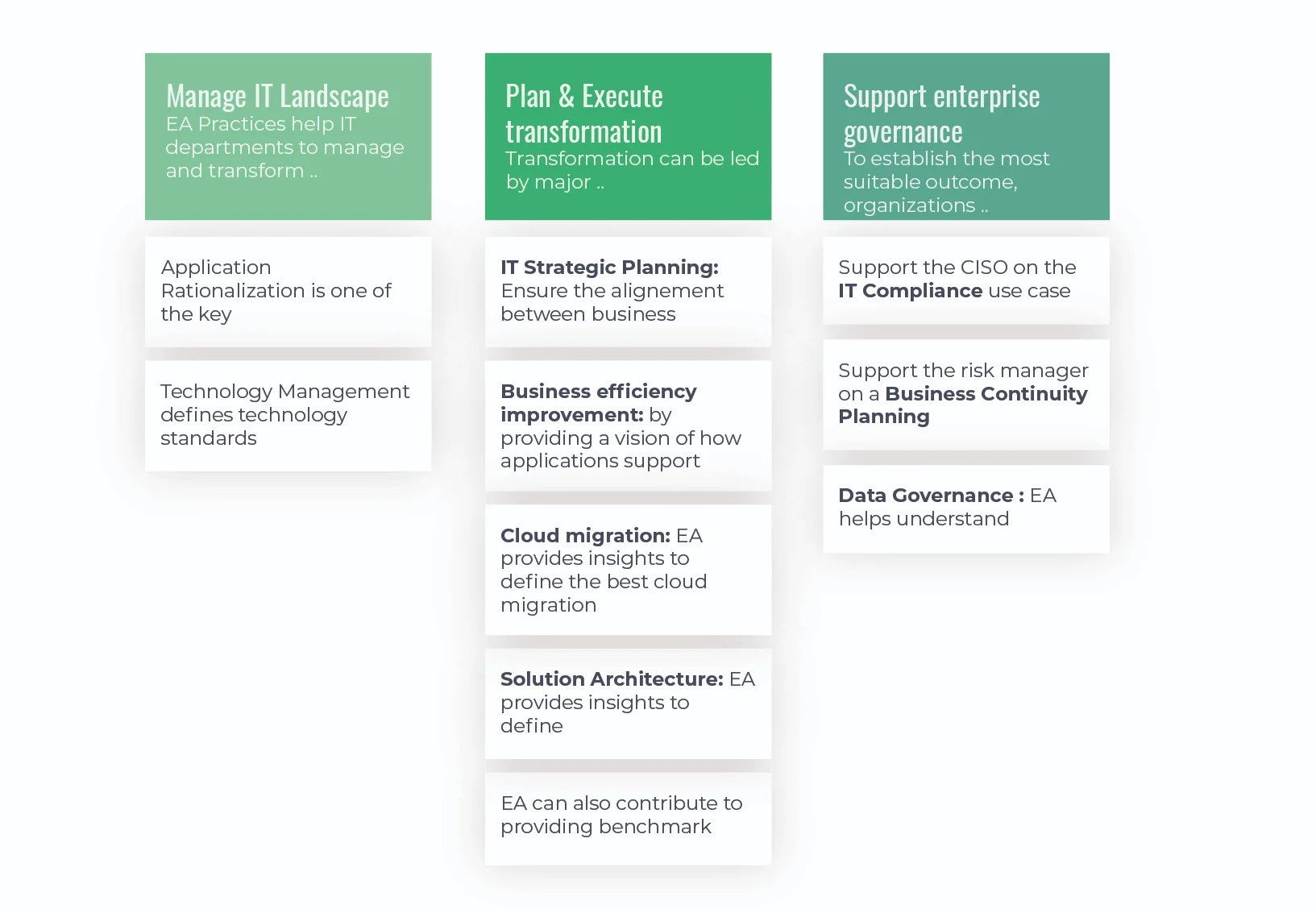
IT landscape management
EA practices help IT departments manage and transform the IT assets of the organization by bringing visibility, impact analysis, and recommendations for two primary use cases:
- Enterprise Architecture is a critical use case for application rationalization. It aims to analyze the IT landscape, detect functional redundancies, identify optimizations, and reduce costs. EA provides clear visibility of existing applications, their link with business capabilities, and their costs, thus enabling organizations to gain insights and make informed decisions for application rationalization.
- Technology management actively defines technology standards, establishes processes to evaluate and acquire technologies, and mitigates the risk of obsolescence by actively managing application and technology lifecycles and proactively detecting potential conflicts.
Plan and execute the transformation.
Organizational changes such as mergers and acquisitions, introducing a new product/service, or modernizing the IT landscape (e.g., moving to the cloud or shifting from a monolith architecture to microservices) can lead to transformation. EA supports business transformation through the following use cases:
- IT strategic planning: ensure the alignment between business needs and IT investments
- Business efficiency improvement: by providing a vision of how applications support processes, EA helps business analysts better understand why some strategies are not performing as expected or are failing to match customers' expectations.
- Cloud migration: EA can identify the best cloud migration strategy by providing insights on which applications to migrate to the cloud and how.
- Solution architecture defines the required architecture for a new IT solution from different perspectives (business, functional, application, technical, and security)
- EA can also contribute to providing benchmarks.
Build resiliency
Organizations can best support enterprise and data governance by combining risk management functions to establish sustainable outcomes.
- Support the CISO on the IT compliance use case by providing an up-to-date IT inventory and regulatory controls to help run regular compliance checks.
- Support the risk manager on a Business Continuity Planning use case by providing a ready-to-use process and application inventory to base business impact analysis upon
- Data governance: EA helps understand the context in which data is used and for what purposes (applications and processes) to improve data quality and ensure data compliance
Enterprise Architecture best practices
Enterprise architecture best practices are essential for businesses to ensure that their IT infrastructure supports their goals and objectives.
A comprehensive enterprise architecture framework can help organizations streamline their processes, reduce duplication of efforts, and optimize their systems. The first best practice clearly understands the business's goals, objectives, and strategies.
The second is to align the architecture with business objectives. The third is to adopt a flexible, scalable, and open architecture that can accommodate changes in business needs. Fourth, evaluate the overall cost-effectiveness of the enterprise architecture.
Fifth, communicate the enterprise architecture framework to all stakeholders to ensure everyone is on the same page. Lastly, evolve the architecture framework to meet the organization's ever-changing needs. By adopting these best practices, businesses can develop a robust enterprise architecture supporting long-term success.
The importance of Enterprise architecture tools and software
Enterprise Architecture is critical for proactively and holistically leading enterprises toward their desired business outcomes. Identifying and analyzing enterprise information using architecture principles is vital for every organization to achieve success. EA delivers value by providing data-driven insights that help architects make informed decisions quickly and confidently.
To manage the complexity of modern enterprises effectively, the use of EA tools and software is essential. While Microsoft Excel and PowerPoint can be useful for corporate architectural planning, they may only sometimes suffice to meet the objectives of an enterprise architecture practice in complex contexts. Hence, developing advanced Enterprise Architecture strategies must use more robust third-party tools and software that apply architecture principles and practices.
EA software provides a single repository facilitating communication and alignment across the organization. Enterprise layers speed up routine tasks and provide data-driven insights to make decisions quickly and confidently. These tools also offer modeling capabilities that allow architects to design all necessary architectural descriptions.
Furthermore, the organization can share these results through collaboration features such as workflows, alerts, and notifications. It is necessary to involve more people in the whole EA process because maintaining an EA repository requires the collaboration of everyone. EA tools automate and accelerate value creation for architects, allowing them to focus on the most valuable activities, such as data analysis and architecture definition.
Features like automatic discovery can automate less-valuable activities like data collection, saving time and minimizing tediousness. Advanced algorithms in next-generation EA solutions also accelerate business decision-making by automatically analyzing the content of the EA repository, providing data-driven insights such as recommendations for application rationale or conflict detection for technology obsolescence management.
To establish an enterprise architecture approach that quickly provides value to stakeholders, organizations should follow a pragmatic, use-case-based approach and focus on tangible outcomes while developing a solid foundation to support business transformations. In this approach, EA management should encompass hardware and software to ensure that every organization can achieve its desired business outcomes effectively.
Summary
In conclusion, enterprise architecture is an essential aspect of business strategy that integrates all aspects of the organization's structure, including its people, processes, and technology. By providing a holistic view of the organization, enterprise architecture enables businesses to make informed decisions and optimize their technology investments. Therefore, organizations must prioritize enterprise architecture in their business strategy to ensure long-term success and competitive advantage in today's rapidly evolving business environment.
FAQs
Enterprise architecture refers to the overall design and structure of an organization's IT systems, applications, and processes. It involves a strategic approach to aligning technology with business objectives and creating a blueprint for the organization's technology infrastructure. Enterprise architecture ensures systems and processes are efficient, effective, and cohesive while allowing scalability and flexibility in changing business needs.
Enterprise architecture is a strategic planning process that enables organizations to align their business goals with technology investments. Enterprise architecture provides a holistic view of an organization's IT infrastructure and ensures that technology investments support business objectives. By defining a clear future state architecture, enterprise architecture enables organizations to make informed decisions about investing in technology to support their long-term strategy better.
Enterprise architecture creates a blueprint or framework that outlines the different components of an organization's IT architecture, how they relate to one another, and their role in achieving its overall objectives. This blueprint guides decision-making when selecting and implementing technology solutions, ensuring they are integrated and effectively support the organization's goals. Enterprise architecture also involves ongoing monitoring and evaluation to ensure that the IT infrastructure remains aligned with the organization's objectives and adaptable to changes in the business environment.
Enterprise architecture tools are software programs used to design and implement an organization's enterprise architecture. They enable users to model and document the components, processes, and relationships of an enterprise's technology infrastructure, business processes, and information systems. These tools can help architects, IT professionals, and business leaders to align the organization's operations with business goals, ensure regulatory compliance, manage risks, and optimize resources. Examples of enterprise architecture tools include:
- Modelling and visualization software.
- Data management tools.
- IT portfolio management systems.
- Business process modelling software.
Overcome digital transformation challenges with Enterprise Architecture

Discover how EA helps you tackle digital transformation challenges and optimize all areas of business.
Enterprise Architecture Related Content
Shift from a documentation tool to an operational tool and accelerate business transformation
MEGA HOPEX for Enterprise Architecture
Request a demonstration of HOPEX for EA, and see how you can have immediate value of your projects.

Valuing intergeneration: an asset for organizations

Valuing intergeneration: an asset for organizations
Less emblematic than diversity or gender aspects, generational issues are often ignored in companies, but they remain a strong signal of the equality policy. Companies have everything to gain from strengthening collaboration between generations.
Intergeneration: Fighting stereotypes and supporting transmission
Senior adults are often considered too expensive, too expert, less motivated, and less agile. The youngest are attracted by innovation, quality of life, teleworking, and the desire to build meaningful careers.
Today, nearly five generations work side by side within companies. Each generation is built on different foundations. At a time when careers are getting longer, companies must tackle the challenge of reconciling their needs with individual expectations.
Organizations must fight stereotypes and value experience and all types of energy while remaining in tune with the signs of the times. They must promote synergies between generations by relying on a solid managerial culture.
The company is an intergenerational and trans-generational mirror of society
The average age is insufficient to determine the number of generations in an organization accurately. Organizations have many differences, but they very often show age biases.
"Seniors are too expensive." "I don't see myself managing someone my parents' age." "What do they understand about digital?" Or, on the contrary, "I don't have time to train a junior." "This generation Y does not know how to work and spends time on smartphones." These central stereotypes convey a biased view of the entire generation and don't consider each person an individual.
This also hides a big difference in the perception of "generational milestones" depending on the businesses or sectors: at 40, the same person may be considered an "experienced" manager in one company or a "senior person" in another!
Whether voluntary or imposed, the absence of generational diversity creates a harmful imbalance for both companies and society.
Intergenerational relationships: sharing, transmitting, growing
Each generation has strengths to share. Thus, the most experienced people can transmit their knowledge acquired through experience, whereas the youngest bring a vision and new tools.
It is up to the company to take advantage of this opportunity and encourage the development of mixed teams. In occupations with a hiring shortage, hiring unemployed people or people from another industry and retraining them is great for companies and people looking for jobs – a win-win for everyone.
Intergenerational equity: a winning strategy to avoid conflicts
Beyond continuous training, the intergenerational dynamic is a particularly effective way to develop each employee's skills, adaptability, and employability.
The company has a fundamental role in the transition and collaboration between generations. Companies have nothing to gain by opposing or comparing generations at the risk of developing rivalries and unfounded discrimination. Performance is built, above all, on collective work and sharing knowledge.
MEGA Leadership Related Content
See the Bigger Picture and Accelerate Business Value
Discover how organizations rely on us to transform their IT
Hear More From Companies Like Yours



